2023 Gift Guide: The Picture Books
November 14, 2023 § 1 Comment
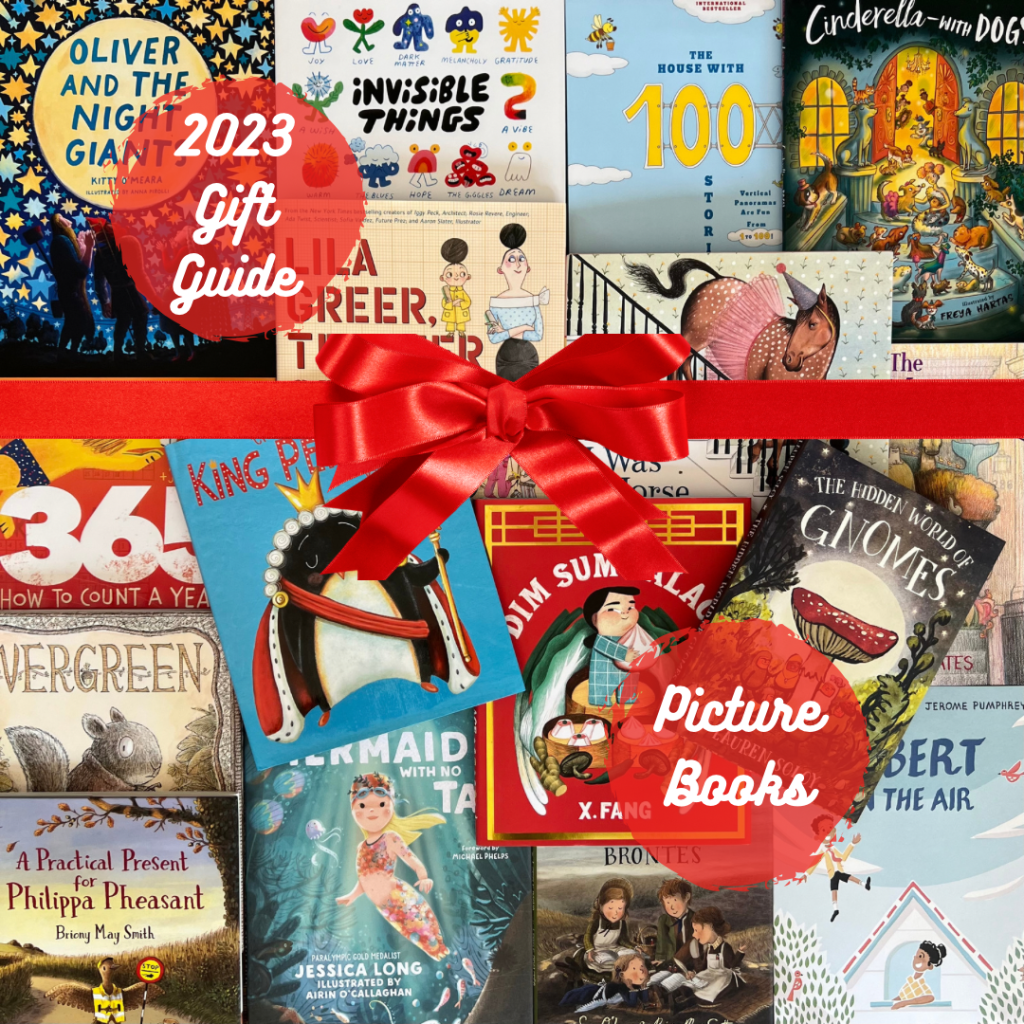
Welcome to the second installment of this year’s Gift Guide, a collection of the giftiest picture books of the year! (If you missed the first installment on Browsable Non-Fiction & Novelty Books, you can catch up here. And stay tuned for lots more posts, including graphic novels and older kid favorites, coming soon!)
It has been another banner year for picture books, and I didn’t have to work hard to find a wide array of memorable stories, unique executions, and beautiful art. The challenge was how to narrow them down! (And then on Instagram y’all pleaded with me not to leave any out…which is why this list includes a few additional titles beyond what I’ve curated for Old Town Books.) I don’t envy you your decisions!
Most of these books are newly published, though there are a handful that came out earlier in the year, without my giving them proper due on the blog. Suggested age ranges are included in every headline, and for those hankering for more photos of interior spreads, my Instagram feed is always good for that.
If you’re near Alexandria, Virginia, I’d love to see you at Old Town Books, where I’ve got all of these picks stocked. And if you have a wonderful indie near you, I’d love for you to support them, too.
Happy reading, happy gifting, happy golden age of picture books! (OUR CHILDREN ARE SO LUCKY.)
For the Developing Math Brain
365: How to Count a Year
by Miranda Paul & Julien Chung
Ages 4-8
The first two picture books on this list are among the cleverest of the year. They also have broad appeal, since what child doesn’t like a book that changes the way they see the world?! The first is 365: How to Count a Year, an especially astute choice for gifting right before the start of a New Year. Anyone else have a kiddo who has difficulty conceptualizing time? Like how long is a year, really? With infectious humor, bold illustrations, and a myriad of different ways to break down a calendar year, this innovative concept book rises to the challenge.
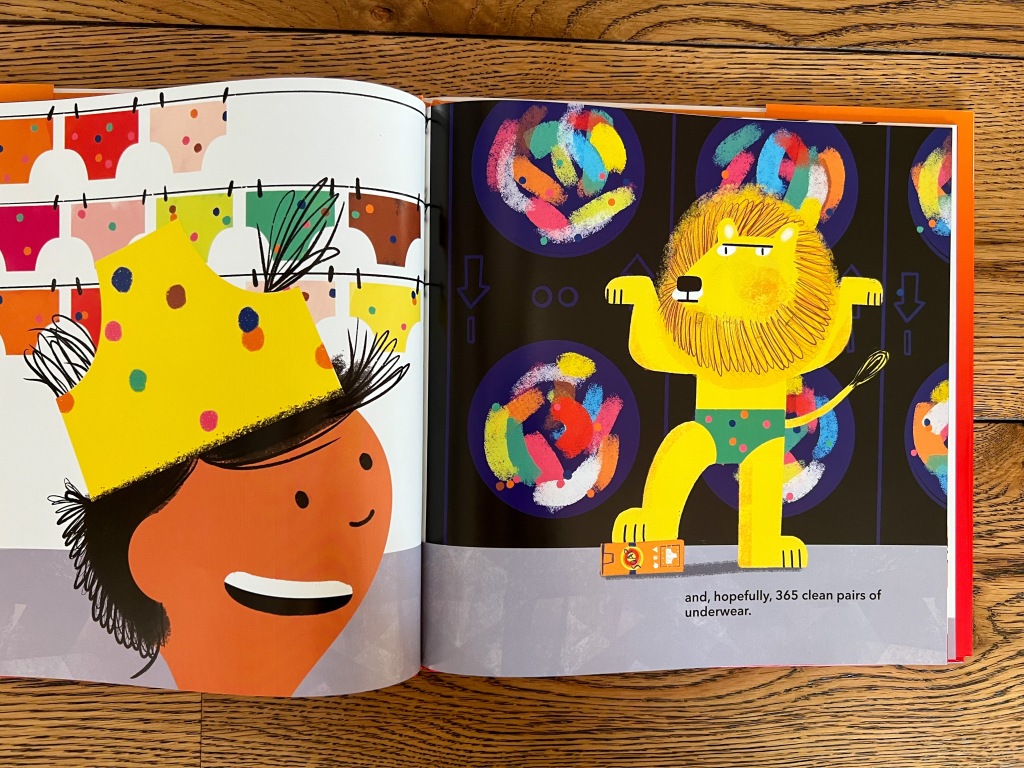
It takes the Earth 365 days to spin around the sun, but what does that really mean? “That’s 365 ‘Good mornings,’ 365 ‘Good nights,’ and, hopefully, 365 clean pairs of underwear.” The book then takes a look at the different ways those 365 days can be broken up into smaller, more digestible chunks, like “52 Friday night movie popcorn spills” or “52 sleep-in Saturdays.” We can also take those weeks and turn them into months to give us “12 monthly clean-the-fish-tank messes.”
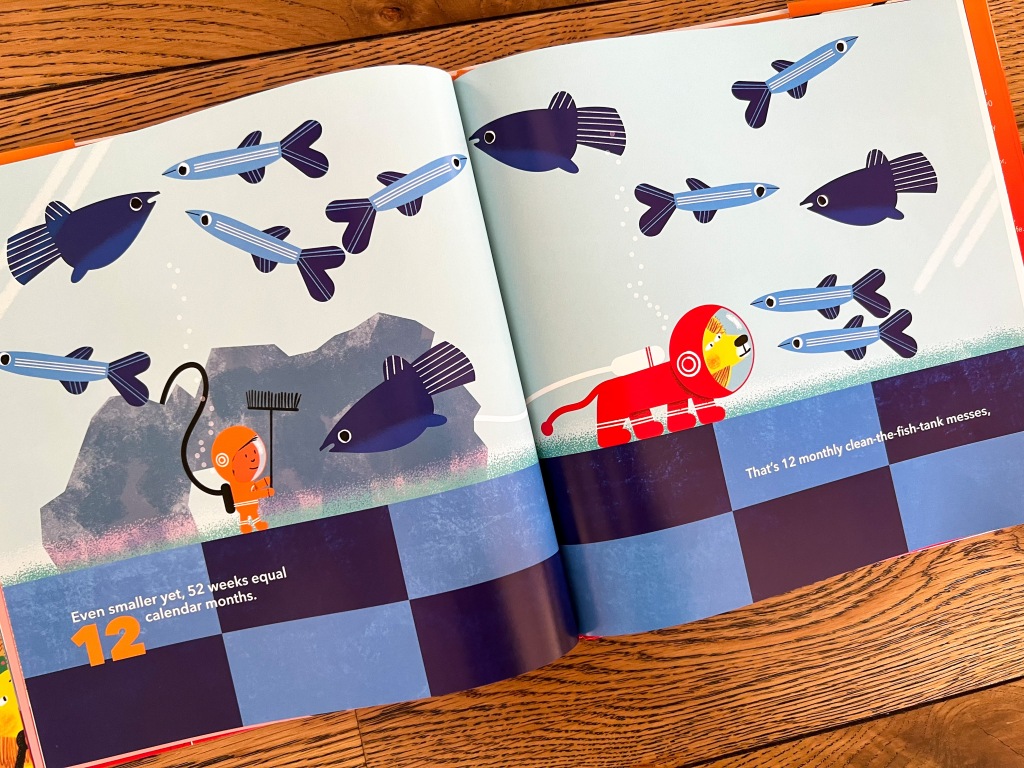
But just when we’re down to one birthday a year, the countdown reverses and this time it accelerates into hours in a year (8,760!), minutes in a year (525,600!), and—hang on, because “you might lose your cool”—31,536,000 “tick-tick-ticks on that clock!” Whew! Good to know I have some time before next year’s Gift Guide.
For the Curious
Invisible Things
by Andy J. Pizza & Sophie Miller
Ages 5-8
If we could put on a pair of magical glasses and see all the feelings, ideas, smells, and other invisible things that populate our world, what would they look like? Could you see an itch? An echo? Hope? Can you think of a picture book that has ever taken on this topic before? It’s no wonder Andy J. Pizza and Sophie Miller’s Invisible Things debuted on the NY Times bestseller list the moment it released this past summer. Taking the premise that there’s more to life than meets the eye, then rendering all manner of invisible things as abstract googly-eyed creations, this playful, conversational book urges kids to see beyond what’s right in front of them.
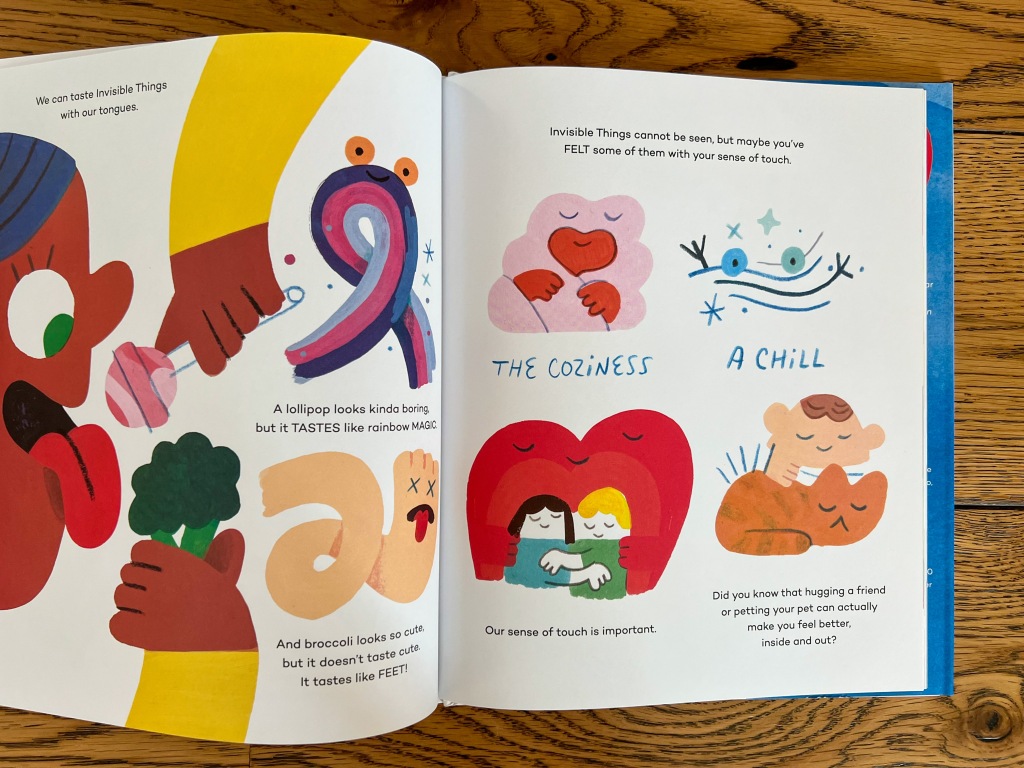
The book starts by asking us to visualize what our senses might be experiencing: tastes, sounds, smells, sensations on our skin. A “song stuck in [our] head” might look like eyes peeping out from inside a guitar with legs, while a whisper might be a grey, amorphous blob with a surprised expression. The taste of a lollipop might look like “rainbow magic.” And while you might assume that anything touching your skin would be visible, have you considered how a chill, or coziness, might show up? Things only get more interesting when we move into emotions, or the vibe of a particular place, or our intuition telling us something important. (What do the “heebie-jeebies” look like?)
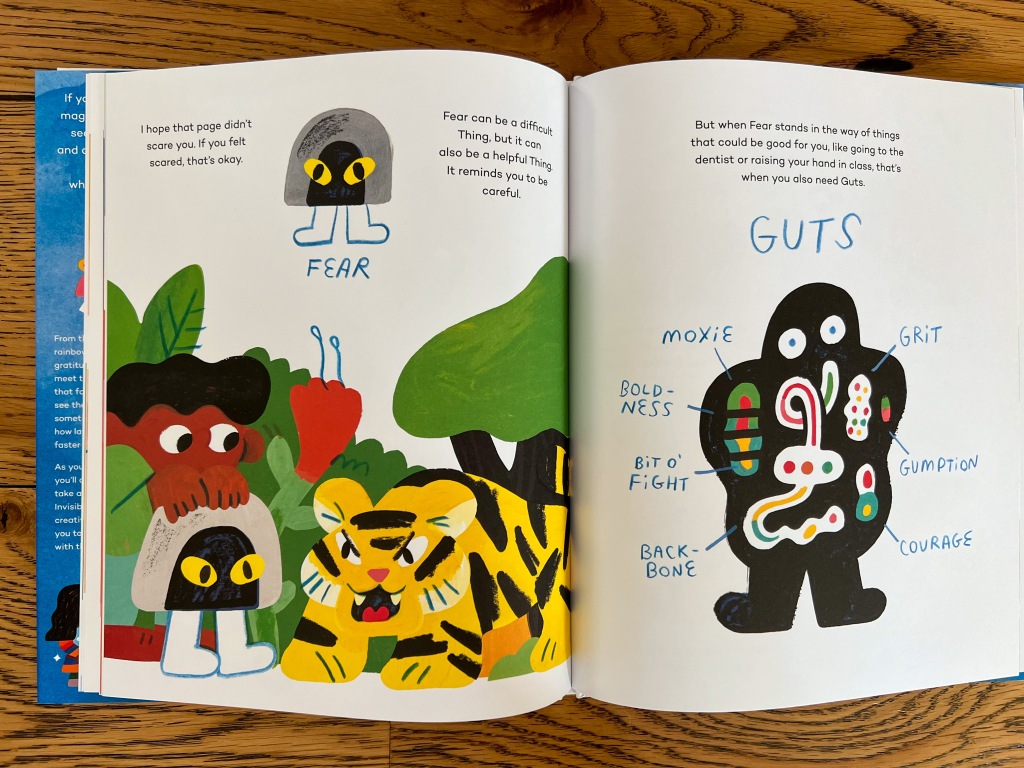
All of this wonder and whimsy add up to a reminder to frequently pause, take a deep breath, and reflect on the invisible but powerful things at work in our everyday lives.
For the Big Boss (little “b”)
The King Penguin
by Vanessa Roeder
Ages 3-7
What do you get the kid who’s maybe a little too bossy? (Asking for a friend.) Hands down, the funniest read aloud of the year is Vanessa Roeder’s The King Penguin, which delivers a lesson on fair and compassionate leadership in between hilarious speech bubbles across a colony of black-and-white chaos. (Learning the names of different penguin species is frost on the cake.)
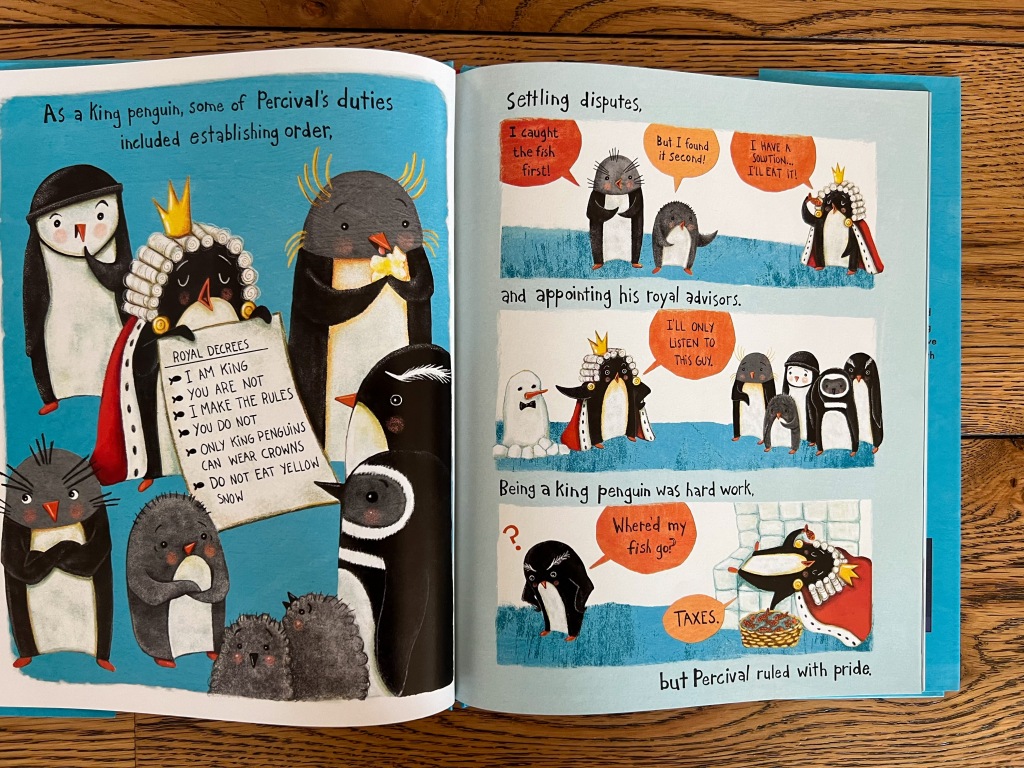
“Percival Penguin was properly pampered, proudly pristine, and practically perfect. He was a king penguin after all. And everyone knows that king penguins rule.” The comedic success of the story comes from the disparity between the lofty language of “royal decrees” and “appointing royal advisors” with the cartoon-like illustrations that show anything but. Percival’s decrees are as random as “only king penguins can wear crowns” and “do not eat yellow snow,” and he quite literally feasts on the taxes he collects. It’s only a matter of time until his subjects begin to question the legitimacy of this dictatorship—“So if I’m a macaroni penguin does that make me pasta?”—and toss Percival to the icy curb.
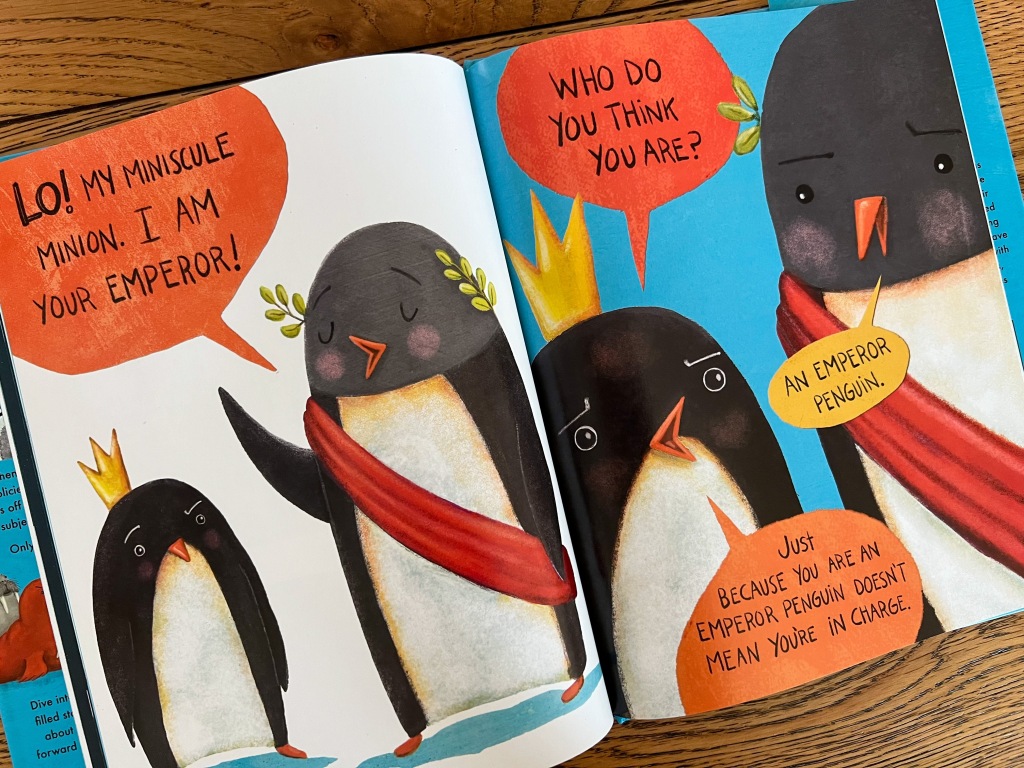
As Percival embarks on a search for a “motley crew in dire need of leadership”—think killer whales and polar bears (we seem to be bouncing back and forth between the poles, but go with it)—it turns out he looks less like power and more like prey. It’s not until he finds himself in a standoff with an emperor penguin that he begins to question his own leadership credentials and decides to return home, still with dreams of ruling, but with newfound humility and an appreciation for the democratic process in tow.
For the “Story” Lover
The House With 100 Stories
by Toshio Iwai
Ages 3-7
This international bestseller, written and illustrated by Japanese creator, Toshio Iwai, and finally translated into English, combines counting by tens with some of the most whimsical visual world building you’ll ever see. Want a book your kids will be looking at long past the time you finish reading? Want a book whose vertical orientation might actually blow their little minds? Let’s just say that both my kids, well above the age range here, were completely taken with The House With 100 Stories. “You know, Mommy,” my daughter proposed, “you could scrap the Guide and just tell everyone to buy this book.” True that.
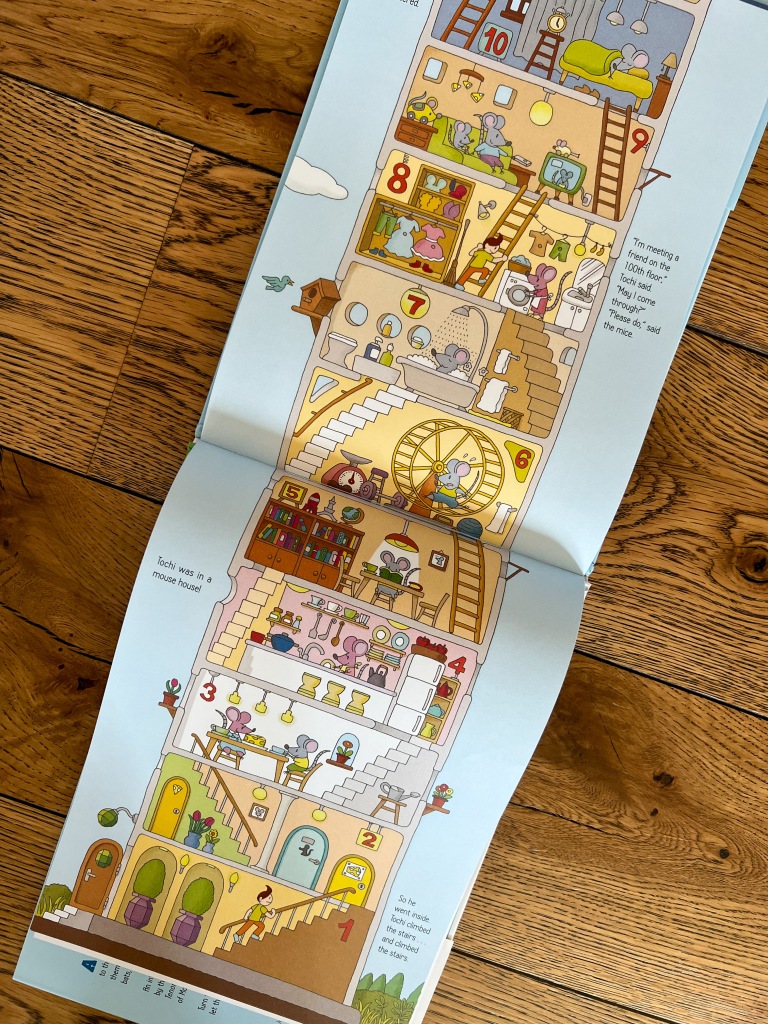
A boy named Tochi’s habit of sky gazing pays off when a letter falls into his hands, along with a map: “Come play with me. I live at the top of the house with 100 stories.” When Tochi reaches the towering building, he begins to climb. Every ten stories cues a page turn, as well as a complete change in both décor and resident—the latter of the anthropomorphic animal variety. We get ten stories of mice, followed by ten stories of squirrels, ten stories of frogs, and so on. The text is minimal, because the fun comes from using our eyes to puzzle out and marvel at the diverse set-ups. (Let’s just say it’s a good thing Tochi doesn’t have to go to the bathroom when he’s moving through the bats’ floors, as their toilet is upside down.)
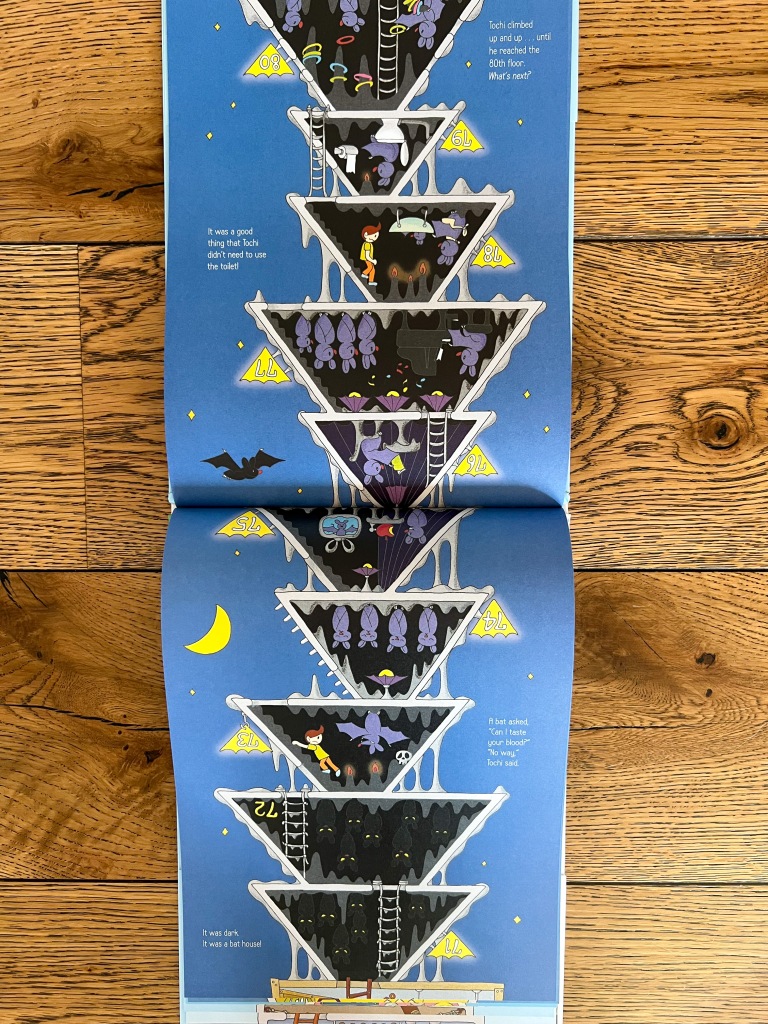
But what does Tochi find at the top of the 100 stories? Will we find out the identity of the mysterious letter writer? And is there another way to get back down?
For the Generous of Heart
The Welcome Home
by Amy June Bates
Ages 4-8
Reminiscent of the companionship in the Amos McGee stories with the chaos of Mr. Watson’s Chickens—two favorites, so how can you go wrong?—The Welcome Home is about a lonely couple who welcomes a menagerie of exotic pets into their home, proving that where there’s love, there’s always room for one more.
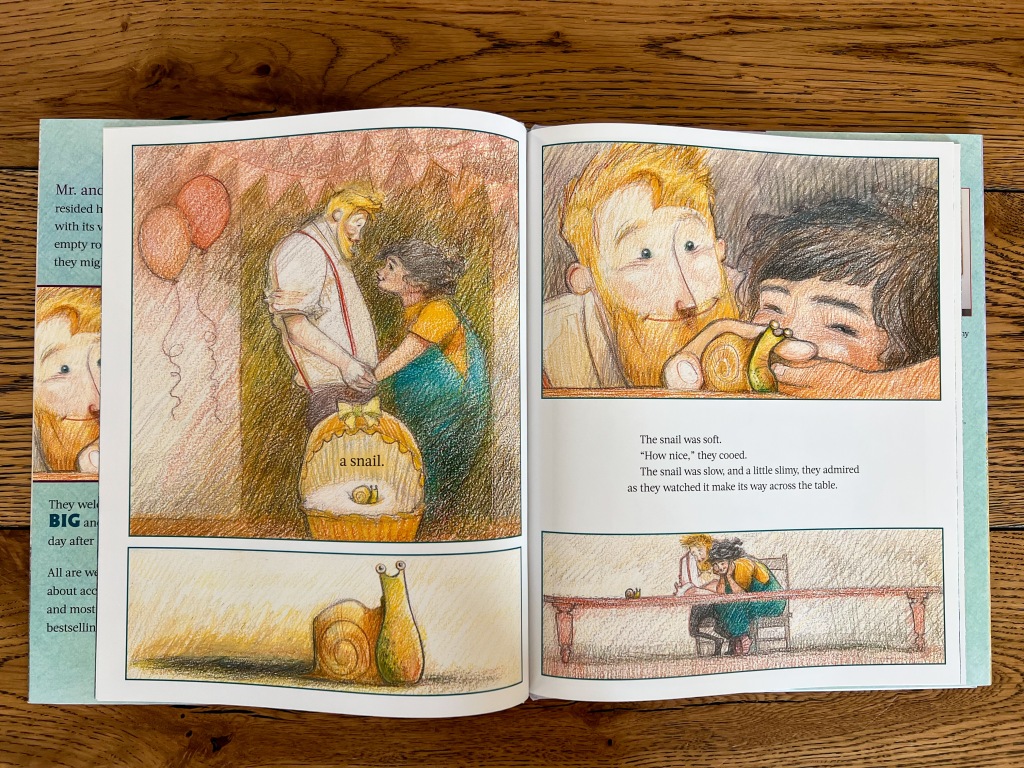
Mr. and Mrs. Gargleson-Bittle (see, it’s already fun to read!) have grown tired of rattling around in a house of empty rooms. Even sky-high piles of waffles with maple syrup only soothe their hearts for a moment. What they really yearn for is a soft, waggy, “little bit lick-your-face-play-fetch-roll-over-rub-its-belly-and-chase-its-tail” companion. The obvious answer is, of course, a dog, but every time you think you know where this story is going, it surprises. Instead of a dog, they get…a snail. The snail, immediately beloved and named Gordon, turns out to be quite soft, but not so waggy. Enter Louise the elephant, who makes a dear but somewhat awkward companion. Cue an aardvark named Sam, a whale named Eugene…you get the idea.
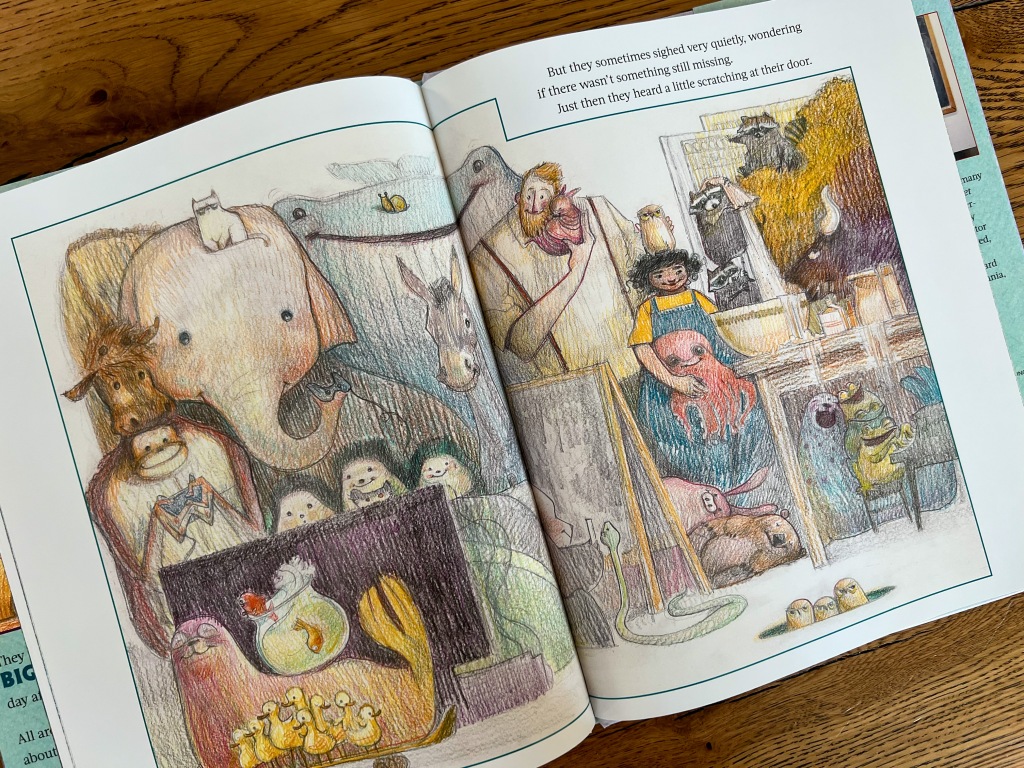
The couple dotes on each new animal as it arrives, gently enfolding it into their happy, if increasingly chaotic, home life. Amy June Bates’ colored pencil artwork is delightfully droll and warmly expressive, and her incorporation of full-bleeds alongside sequential panels lends perfect pacing to this story of inclusion and acceptance. But will this couple end up with a dog at the end, or not?
For the Epicurean
Dim Sum Palace
by X. Fang
Ages 3-7
And the award for the most exquisitely designed picture book of the year goes to Dim Sum Palace, an extraordinary debut by Taiwanese American creator, X. Fang, which is as much fun to read aloud as it is to marvel at. Now, fair warning: if you love dim sum as much as the little girl in this story, then this book is going to make you very, very hungry, from the spectacular graphite artwork to the endpapers that read like a catalog of dim sum to the simulated menu hiding underneath the jacket cover. And if you haven’t experienced this particular eating experience, then you’re going to be googling Chinatown recs as fast as you can.
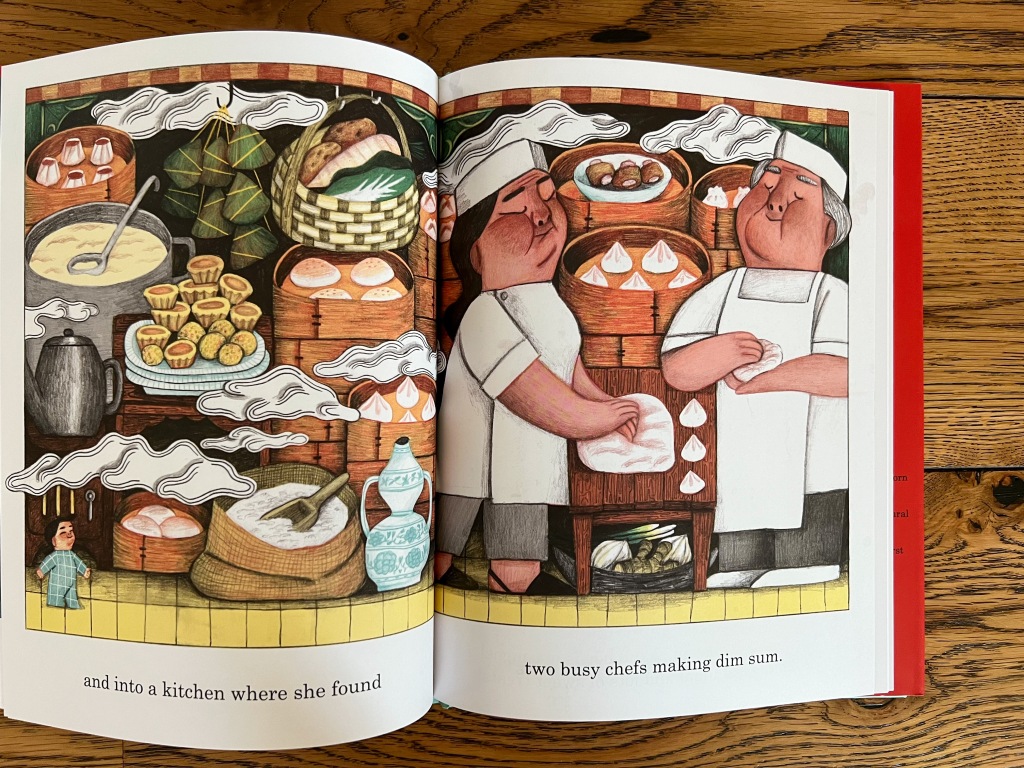
Reminiscent of Maurice Sendak’s trippy In the Night Kitchen (without the nudity), the story takes us inside a dim sum lover’s sleep-induced fantasy. With the delicious anticipation of her family’s first visit to the restaurant chain Dum Sum Palace the next morning, Liddy lies in bed wondering what such a palace might look, smell, or taste like. Before the knows it, she’s inside this palace of her dreams, manned by two busy chefs and piled high with towering, mouth-watering “baos, buns and bowls of congee! Dumplings, shumai and lots of sweet treats!” But as she climbs up the side of one particularly tempting dish, she—oops!—trips and falls into a bowl of dumpling filling. Before long, she is scooped up and pressed into a dumpling that’s fit for the Empress herself. Eeek! Can she keep the Empress from eating her before she wakes up?
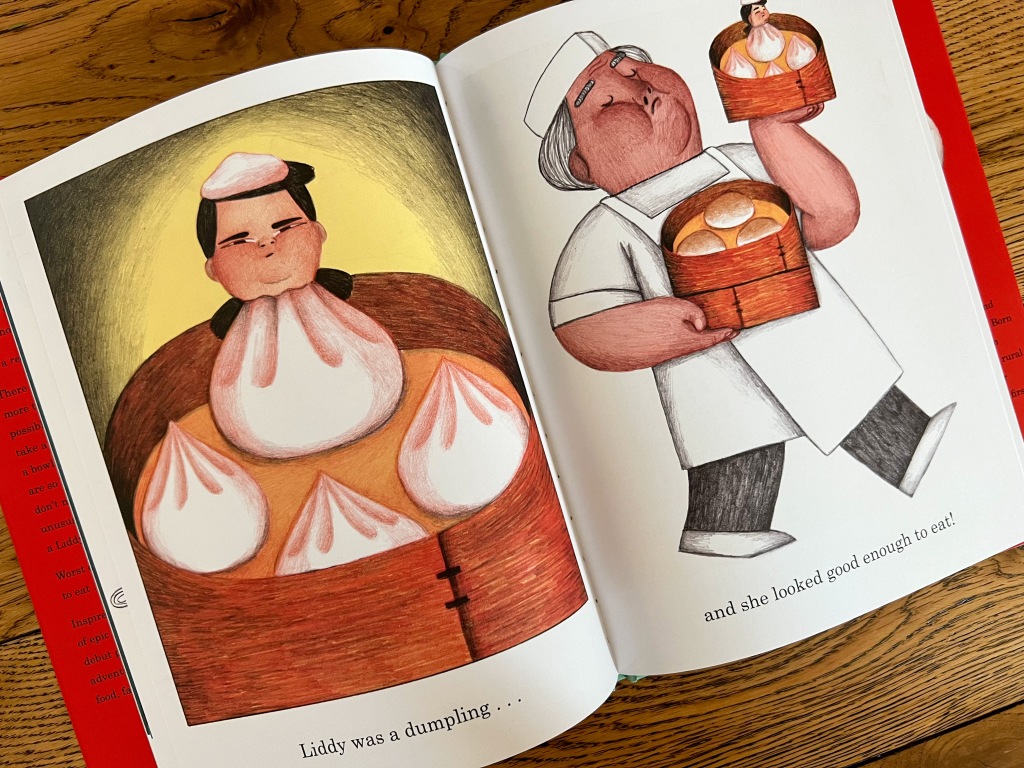
An inventive tale that serves up an homage to agency as delightfully as it does yummy, yummy dim sum.
For the Mermaid Lover
The Mermaid With No Tail
by Jessica Long; illus. Airin O’Callaghan
Ages 4-8
With mermaid stories a dime a dozen, The Mermaid With No Tail is the fresh twist your mermaid lover doesn’t even know she needs! Written and inspired by the real-life story of Jessica Long, a Paralympic gold medalist, and with a forward by Michael Phelps, it’s an allegory of empowerment in the face of disability. And with its shimmering palette of blues and pinks, as well as a myriad of tantalizing touches, readers won’t be able to get enough.
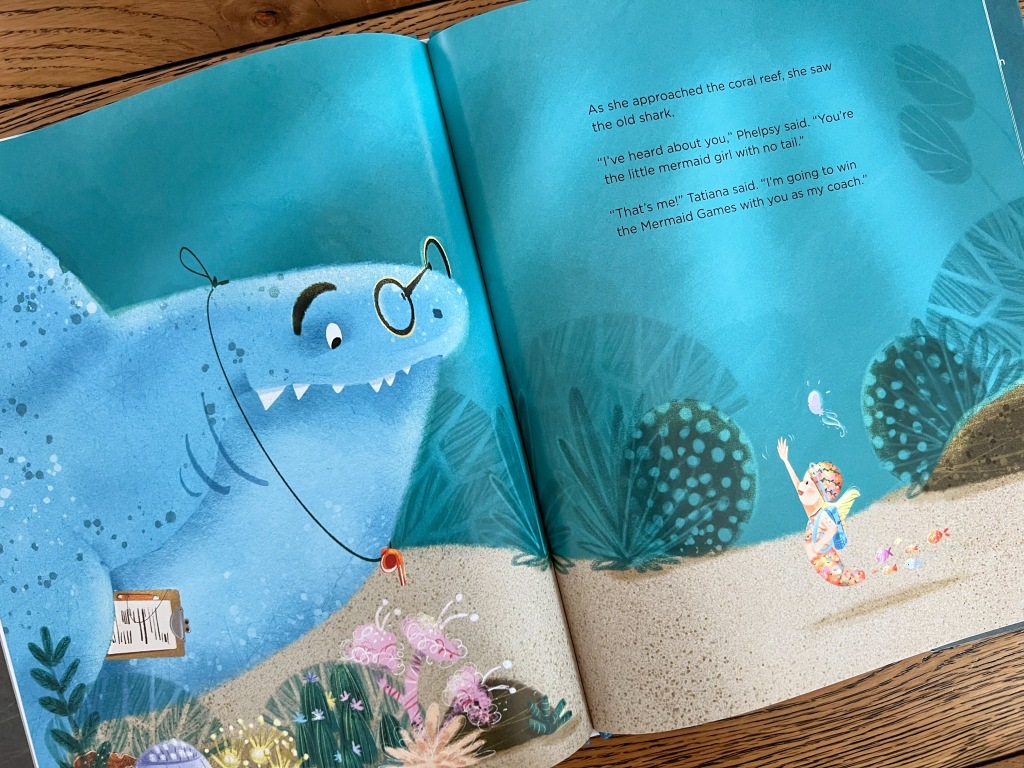
“Imagine a mermaid with no tail. Her name was Tatiana.” Tatiana, taken in when she was small by a family of sea turtles, spends her days mostly without playmates, the other mermaids unable to fathom that a mermaid without tail fins could be like them. But Tatiana, emboldened by her family’s unconditional love, is determined to “wear the winner’s trident shell around my neck for everyone to see” by beating the other mermaids in the prestigious Mermaid Races. But when most mermaids rely on their tails to propel them through water, how can a mermaid without a tail achieve the same results?
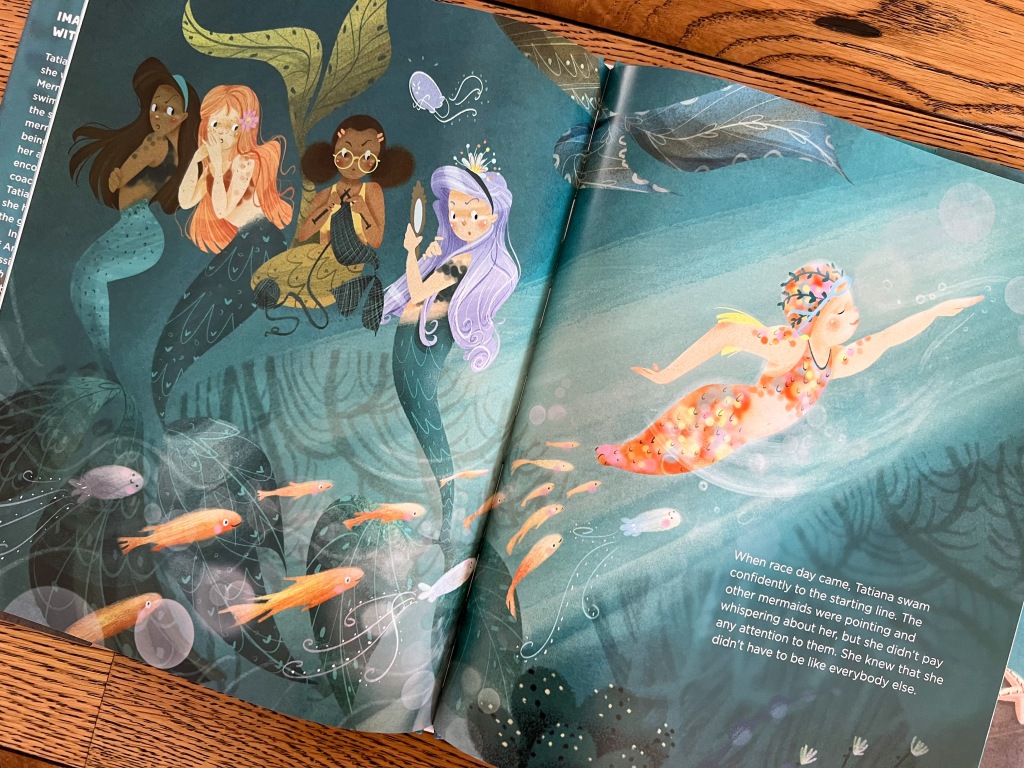
The answer comes from a shark coach named Phelpsy (wink, wink), who encourages Tatiana to “think about what you do have instead of worrying about what you don’t.” The exciting race that concludes the story highlights the importance of persistence, hard work, and a refusal to let our limitations define us. This mermaid kicks some serious tailless butt!
(If you want a non-traditional title for a unicorn lover, you must check out the gorgeous Manolo & the Unicorn!)
For the Future Teacher
Lila Greer, Teacher of the Year
by Andrea Beaty; ills. David Roberts
Ages 4-8
Andrea Beaty and David Roberts keep thinking up ways to outdo themselves in their hugely popular “Questioneers” series, and in Lila Greer, Teacher of the Year, they turn the spotlight on the beloved second grade teacher of Blue River Creek School, showing us what she was like as a young student. The rhyme is on point. The clothing and hairstyles are as fabulous as ever. But the real reason this new title is going to win over so many young readers (as well as their teachers) is because it represents something increasingly familiar to our kids. I’m talking about anxiety—or, as Lila thinks of it, the “what ifs.”
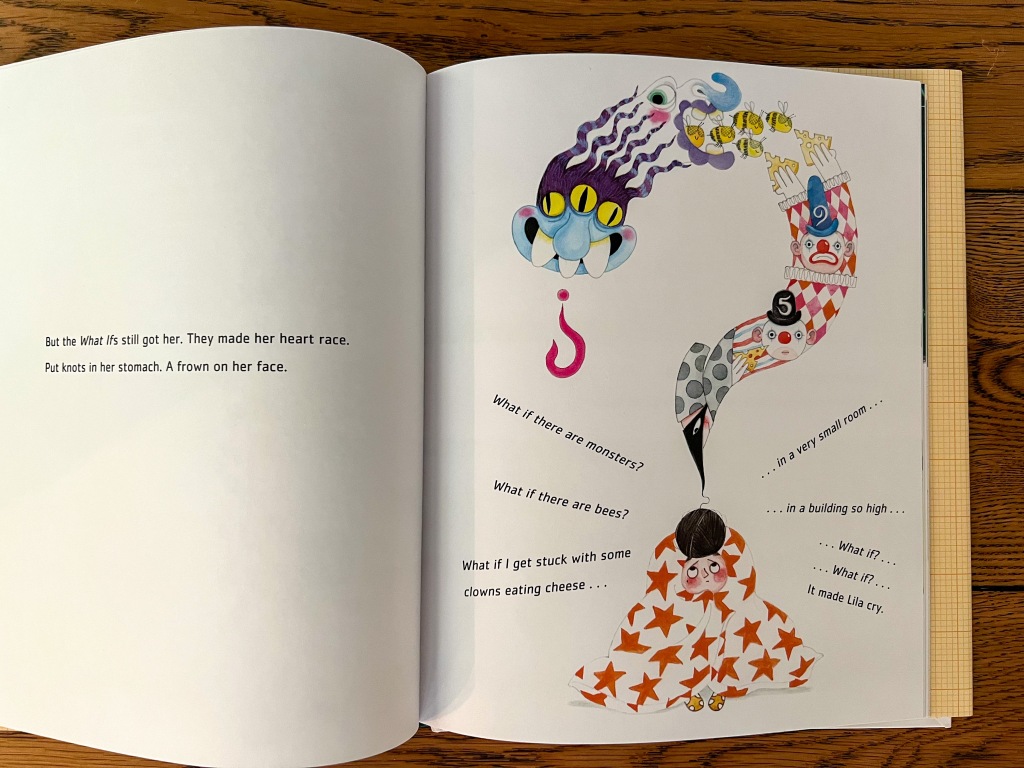
“What if there are monsters? What if there are bees?/ What if I get stuck with some clowns eating cheese…” These types of thoughts have always nagged Lila, but they’re especially prevalent when a move to a new house and a new school turns her life upside down. In a new second grade classroom, everything feels odd, from the smells to the kids, so Lila keeps to herself, her trademark curl atop her head the only perky thing about her. After all, if you don’t put yourself out there, you can’t be hurt. Right?
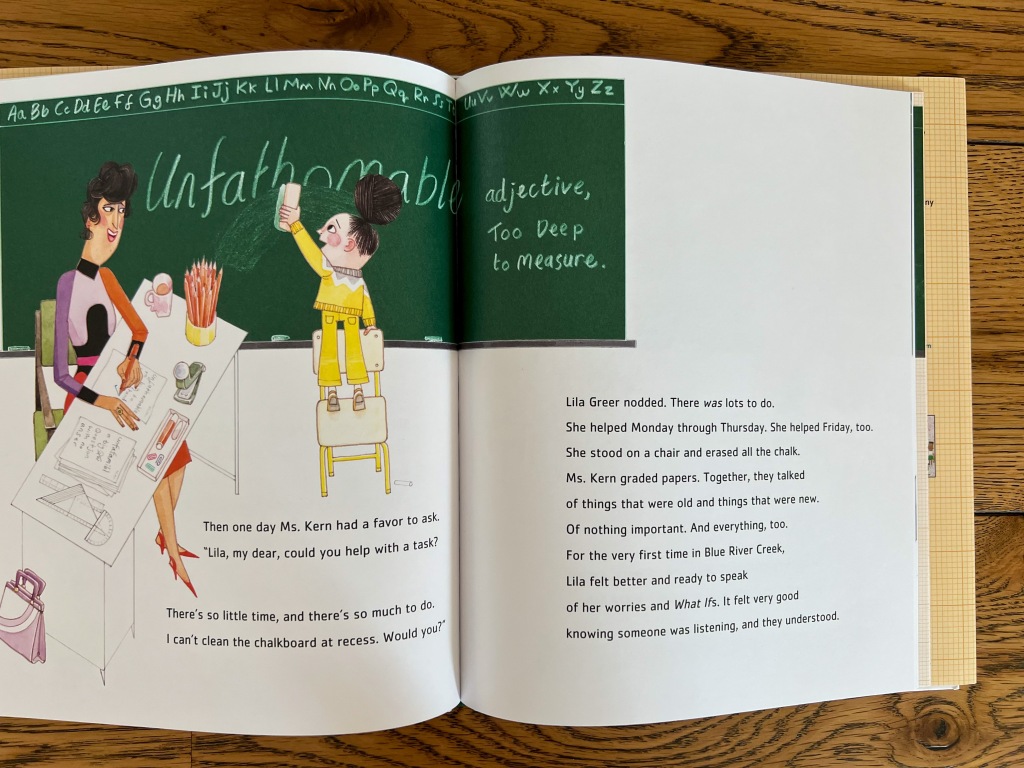
It turns out Lila’s teacher, Ms. Kern, has a few tricks up her sleeve, even if Lila isn’t the wiser until many years later when she becomes a teacher herself. Watching young Lila’s own transformation to becoming an active, confident member of her classroom makes us love and appreciate even more the teacher she later becomes, reminding us that the best teachers are the ones who take time to really *see* their students. Cue the tissues.
For the Artist
Oliver and the Night Giants
by Kitty O’Meara; illus. Anna Pirolli
Ages 4-8
Each year, I try to find a unique take on the bedtime trope, and I hit the jackpot with Oliver and the Night Giants, a story about a boy who assists in the work of mending the world. Can you think of a more apt message for these times? Boasting some of the dreamiest artwork of the year, this gem heralds creativity, self-discovery, and the assertion that everyone has the potential to make the world a more interesting, beautiful place.
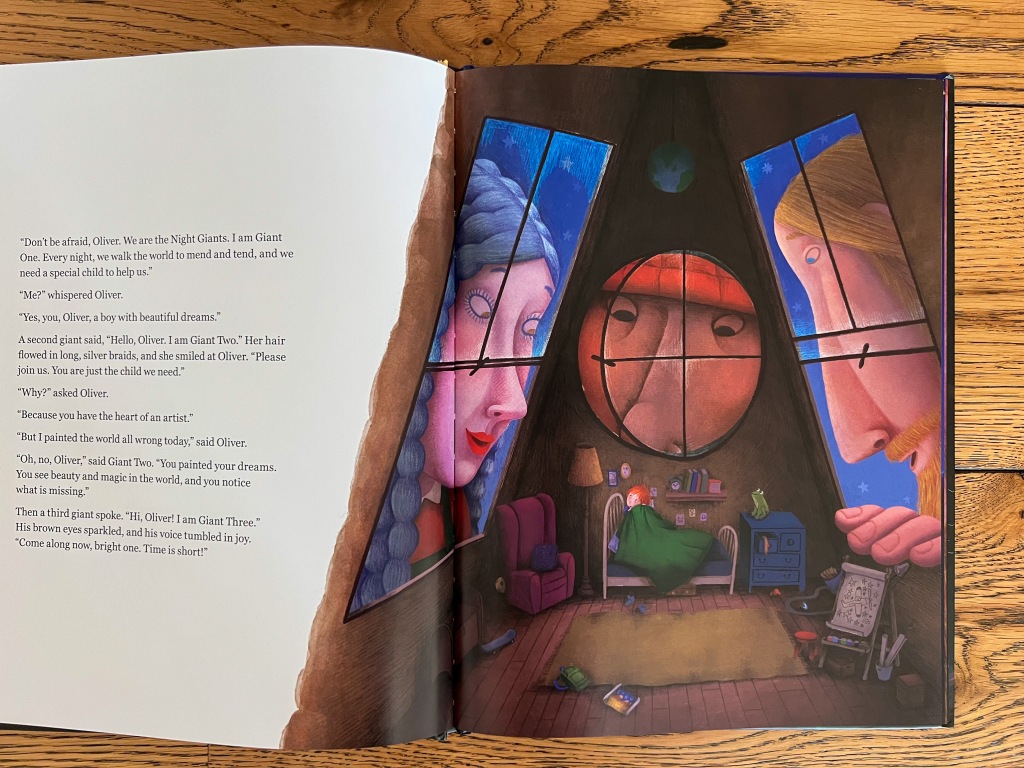
Oliver’s deepest joy is sparked when he is making art. But his classmates’ jests—“That’s not how the world looks!”—cause him to doubt his creative choices. On the evening of one Disappointing Day, just as Oliver is drifting off, three giants appear at his bedroom window: “Don’t be afraid, Oliver. We are the Night Giants. […] Every night, we walk the world to mend and tend, and we need a special child to help us.” For his ability to look at the world and “see what is missing,” Oliver is the chosen one. He jumps into the proffered hand and is transported into the chilly night.
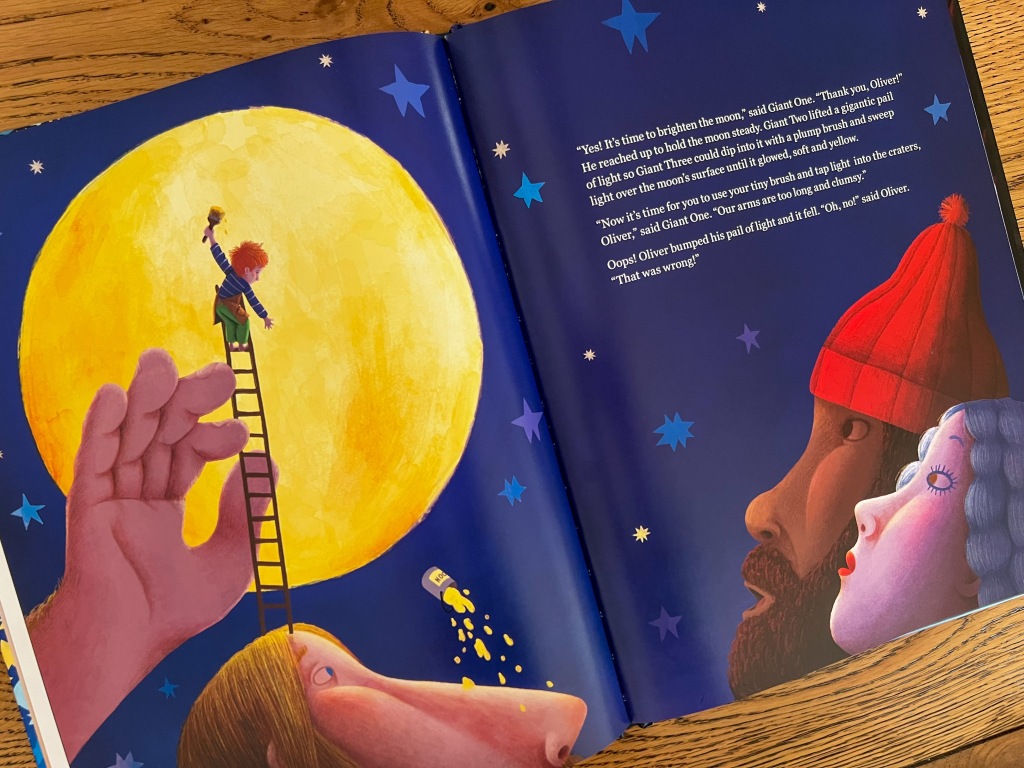
The Giants invite Oliver to add his own creative flourishes to the sleeping world. He paints jewel-like stars to light up the sky and crooked mountains to make the horizons more interesting. He cuts delicate snowflakes out of special dough, fluffs up clouds, tickles waterfalls, stirs the wind to make music, and shakes fruits and nuts from the trees so the animals can eat well come morning. Back in bed, Oliver sleeps the sleep of the contented, because the “world is always magical to those who follow their dreams.”
For the Individual
Elbert in the Air
by Monica Wesolowska; illus. Jerome Pumphrey
Ages 4-8
Monica Wesolowska’s Elbert in the Air isn’t just one of the sweetest, quirkiest books of the year, it can also be read as a metaphor for any number of marginalized differences, including neurodiversity or gender identity. It’s about a boy who was born to fly—literally!—and the support he gets from his mother—an inspiration for us all!—to be fully himself.
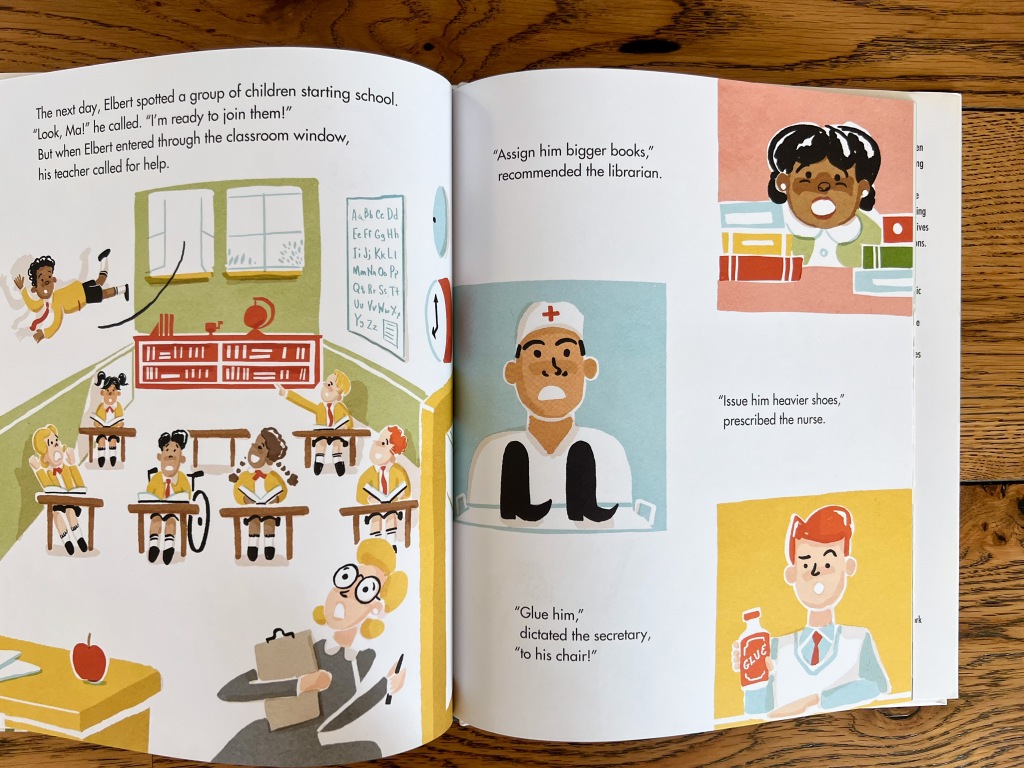
“Shortly after he was born, Elbert floated into the air.” When word gets around that Elbert’s ma has to stand on tiptoes to feed a bottle to her hovering infant, advice starts pouring in: “Net him like a butterfly!” “Reel him in like a kite!” As Elbert advances to school age with no sign of being able to ground himself, no sign of “fitting in,” he faces the same skepticism from his teachers, who propose he read bigger books, wear heavier shoes, or even glue himself to his chair. All the while, Elbert’s mom has his back, insisting that “if Elbert was born to float, you should let him!”
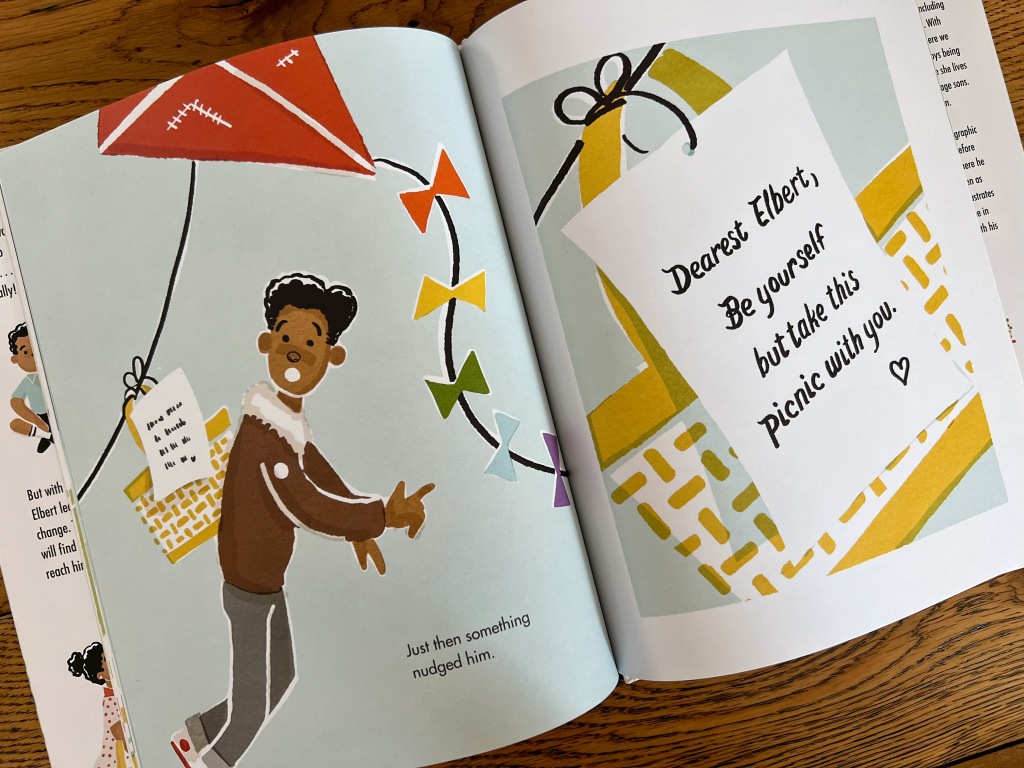
But life in the air is bittersweet for its loneliness. That is, until a heartwarming resolution reminds us that even if it takes a little time, it’s always worth seeking out communities where we can be celebrated for who we truly are.
For the Civic Minded
A Practical Present for Philippa Pheasant
by Briony May Smith
Ages 3-7
That A Practical Present for Philippa Pheasant is by Briony May Smith, the British creator behind Margaret’s Unicorn and last year’s Gift Guide pick, The Mermaid Moon, should be reason enough to head straight to your bookshop. The sun-dappled illustrations drop us in the middle of the quaint English countryside, where we are content to stay for a timeless tale of giving back to community. But should you desire another reason, how about Philippa herself? She’s plucky, resourceful, and she takes matters into her own feathers to make the streets safer for critter-kind. (I could also add that my daughter picked this as her favorite picture book of the year.)
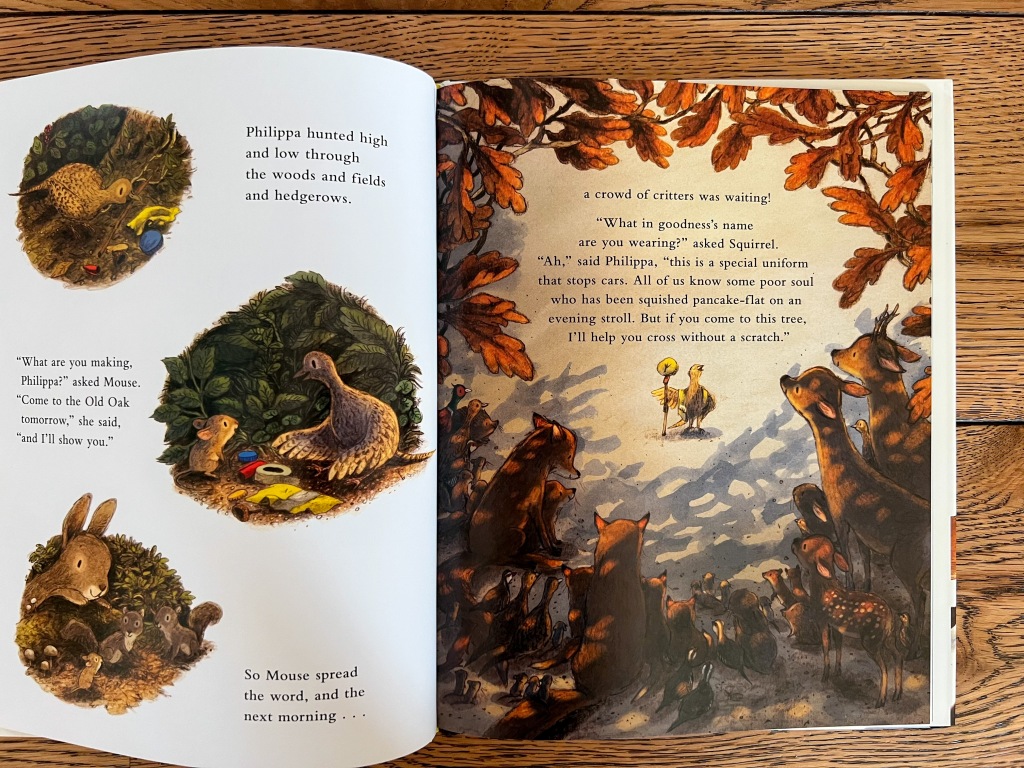
Despite the bucolic setting of the village of Fairhurst, Philippa Pheasant is plum tired of crossing Old Oak Road to feast on delicious blackberries, only to be “nearly knocked pancake-flat” by a car “whizz[ing] past.” When, one day, she spots (human) schoolchildren crossing a different street with the help of a “tall woman in a bright-yellow uniform,” Philippa fashions her own vest and makeshift stop sign and begins to hold up vehicular traffic at the favorite crossing spot of her woodland friends.
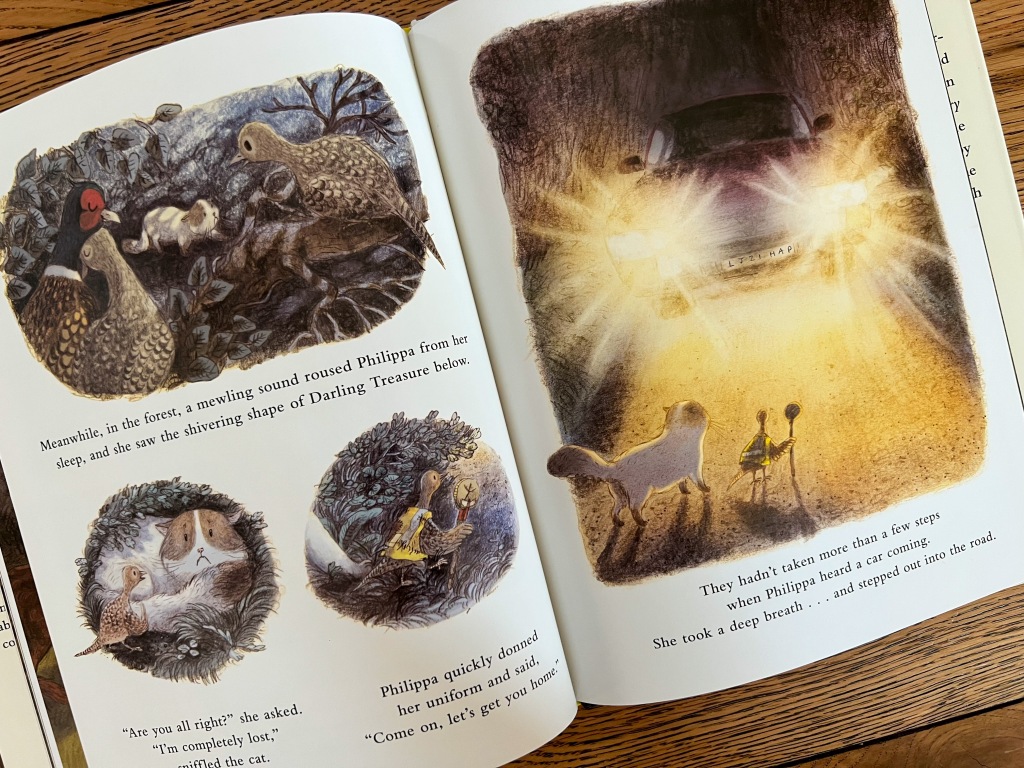
Deer, bunnies, and squirrels alike are delighted to take her up on her offer, and soon our “peculiar pheasant” finds herself in the spotlight of the village newspaper and news channels, much to the dismay of the (human) Mayor, who would rather people focus on his “bake sale or tree-planting scheme.” But when the Mayor’s cat, Darling Treasure, runs off to see this pheasant for herself and gets turned around, Philippa is called upon to save the day.
For the Bookworm
The Little Books of the Little Brontës
by Sara O’Leary; illus. Briony May Smith
Ages 4-8
One of the best days of my life was spent alone, just out of college, outside Howarth, England, the birthplace of the Brontë siblings: a tiny brick Parsonage surrounded by the wild, wind-whipping moorlands. It was everything I imagined after falling in love with Charlotte Brontë’s Jane Eyre as a teen and then devouring everything I could about the life and works of this peculiar family, who channeled sadness into story. Now, you’re thinking, “Sure, I love the Brontës, but will my littles care about this picture book?” To which I say, this is not a picture book biography. The Little Books of the Little Brontës (ages 4-8) is an ode to the coziness of siblings, the delight of imagination, and the power of story. It’s for budding bookworms and bookmakers alike. And it exudes giftiness, with its smaller-than-normal trim size, its surprise under the case cover, and its gorgeous mixed-media illustrations. (Yes, this is the second Briony May Smith title on this installment of the Gift Guide, because I can’t stop, won’t stop.)
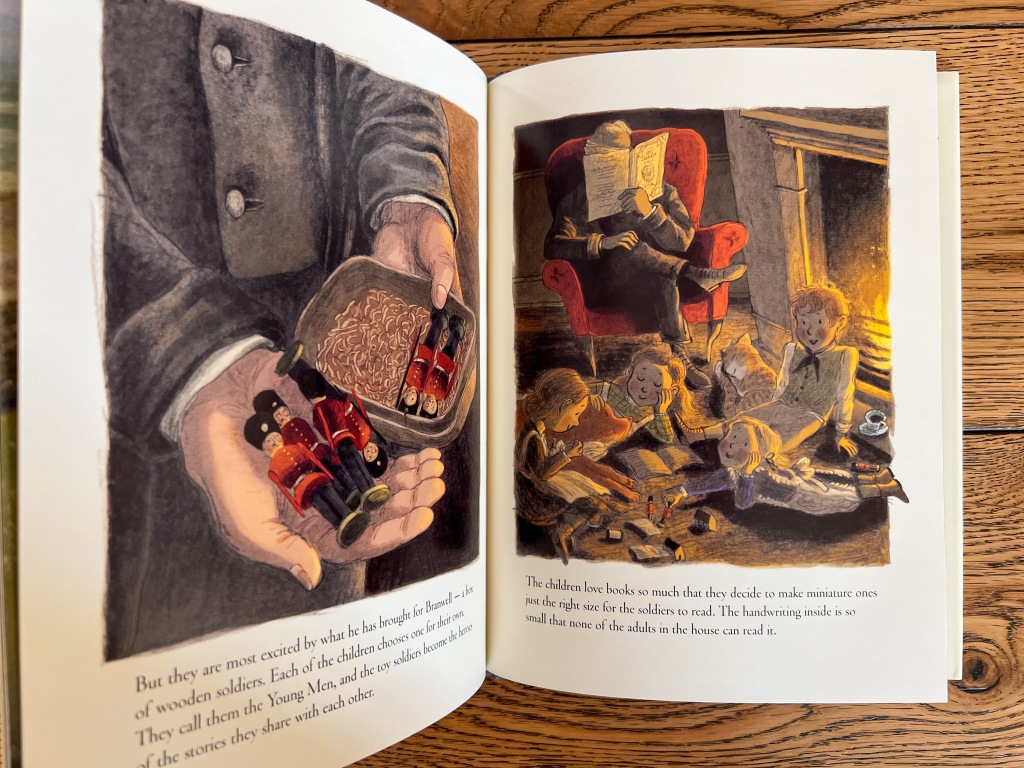
Sara O’Leary’s text is inspired by the miniature storybooks that the reclusive, motherless Brontë siblings—Charlotte, Branwell, Emily, and Anne—made for one another out of wallpaper scraps, watercolors, and hand-stitched pages, their insides full of inventive stories written in print legible only to their youthful eyes. These little books, spurred into creation after Papa gifts Branwell a box of toy soldiers—because what soldier doesn’t need a book to hold?!—give the children “a world unto themselves,” for “the books they write are tiny, but the worlds inside them are huge.”
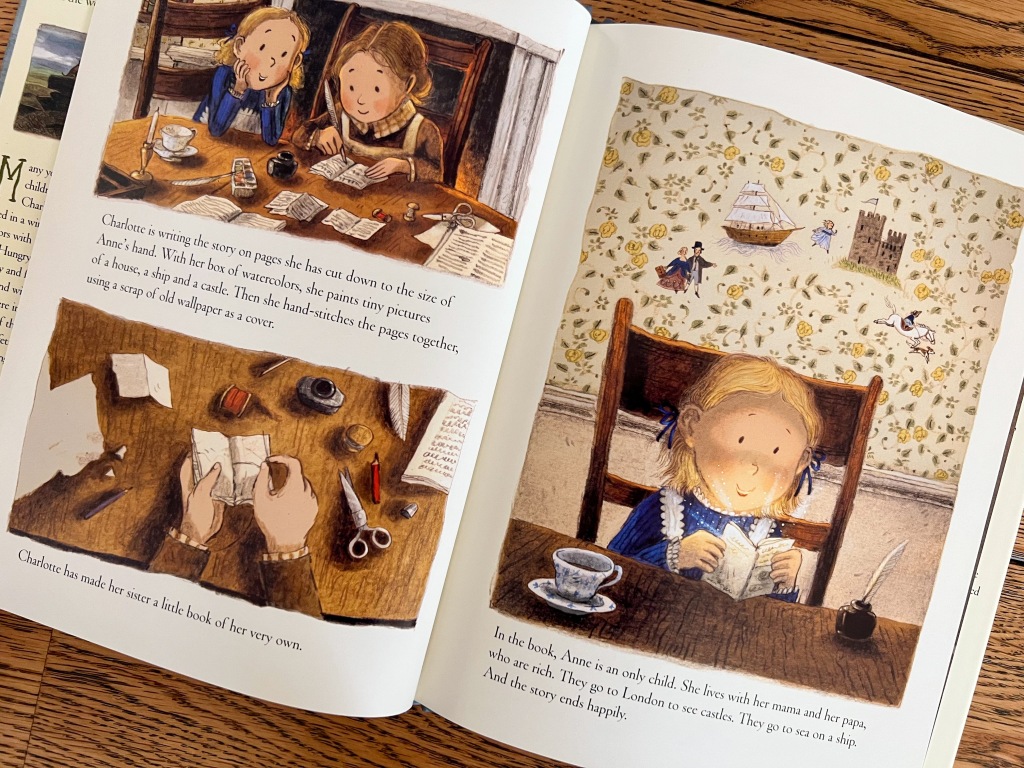
The book ends with instructions on making your own little book, with a photo of some of the Brontës’ creations that survive today. Oh, my heart!
For the Pretender
If I Was a Horse
by Sophie Blackall
Ages 2-7
It’s a truth universally acknowledged that two-time Caldecott Medalist Sophie Blackall is incapable of making picture books that aren’t exquisite, but did you know she can be quite funny, too? Her newest, If I Was a Horse, an ode to the child’s imagination, brims with whimsy, each spread reveling in its good-natured humor. It’s also read-aloud perfection—nary an excess word!—which is key, because you’re going to be reading it on repeat.
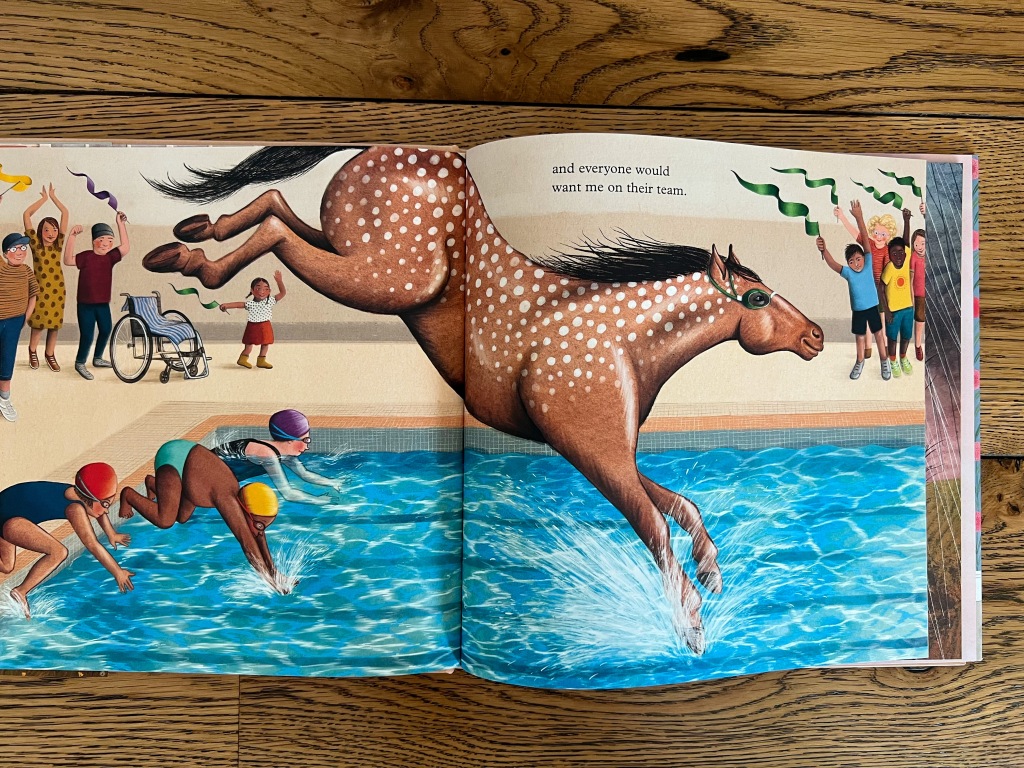
Some kids imagine themselves as a princess or fairy, fire fighter or doctor. Our young narrator prefers to consider the benefits of being a horse. A horse that still does kid things, that is. In a matter-of-fact tone, all the more charming for its seriousness, we are given a front row seat into this well-considered vision. “If I was a horse, I would gallop all day. I could go anywhere I want, and I’d come home when I was hungry.” Indeed, the funniest part of this conceit comes from the interjection of a giant horse into the familiar, day-to-day settings of the child’s life: the family dinner table, the bedroom, the school hall, even a swim meet. Just imagine what you could get away with as a horse! Why, nobody could make you take a bath, and you wouldn’t even have to wear clothes (unless they were dress-up, of course). Plus, you could be helpful and give your sister a ride to school!
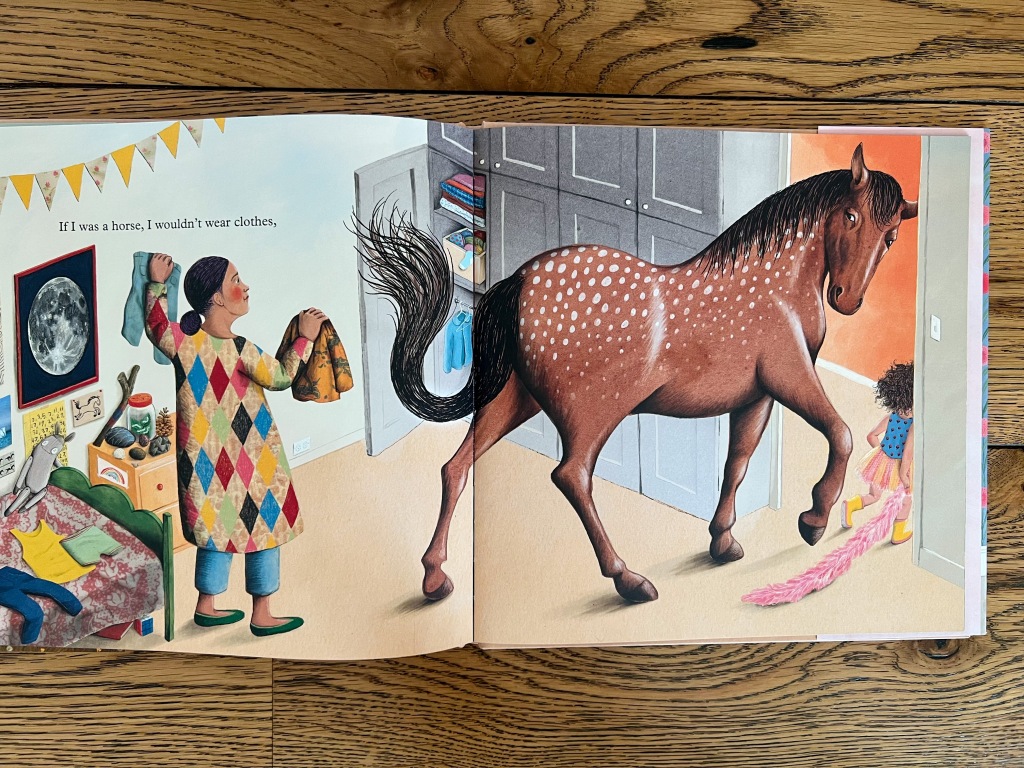
As always, Blackall delights with color, pattern, and form, from the wallpapered walls, to the bright swim caps, to the gentle, expressive contours of the horse’s body (even its white spots are divine!). We only need to regard that wry glance back at the mom holding clothes she’d very much like the horse to put on, to know that the personality of its child creator resides inside. And the pièce de résistance? The glittery tutu on the cover, of course.
For the Unconventional Princess
Cinderella—with Dogs!
by Linda Bailey; illus. Freya Hartas
Ages 3-7
A Cinderella retelling but make it feminist and for dog lovers? This is the stuff that dreams are made of! Linda Bailey and Freya Hartas have teamed up to tell the delightful, giggles-inducing story of Cinderella—with Dogs! When Cinderella wishes for a fairy godmother, she gets a “fairy dogmother” instead, complete with a pink tiara and tutu.
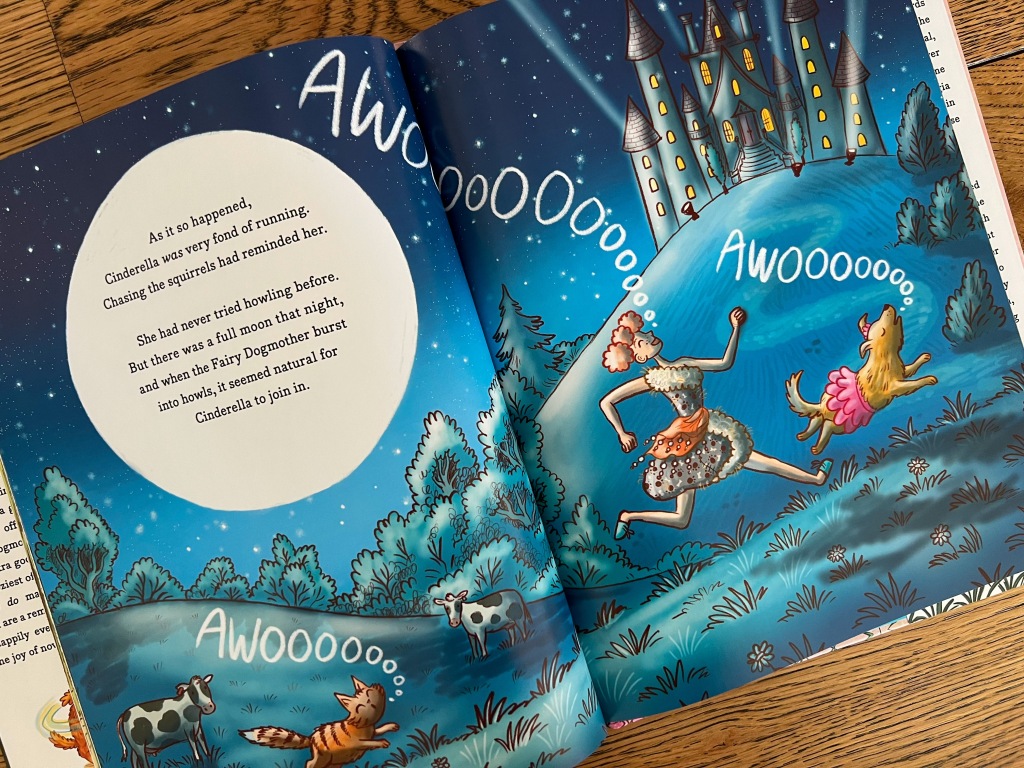
Cinderella can’t bear the sad look on the pup’s face when she explains she’d actually wished for a fairy god-mother, so she goes with it. (After all, “she knew how it felt to be unwanted.”) The dogmother immediately orchestrates a squirrel chase through the garden to cheer up his obliging subject, before donning a magic wand and fashioning a smelly, fleecy dog blanket for her to wear as a dress for the ball. But it’s the poodle hairstyle that will really make Cinderella—good sport that she is—stand out in the crowd.
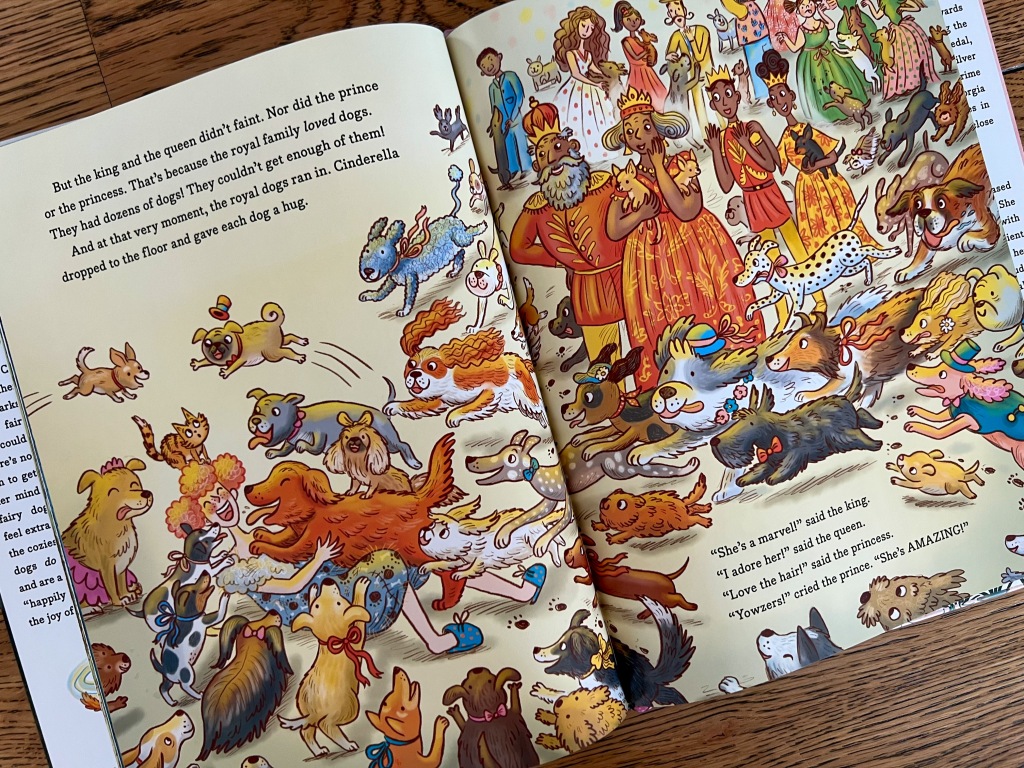
When Cinderella arrives at the ball—after a good howl at the moon—she turns heads for her unusual attire, but it’s her playfulness with the royal dogs who swarm her that attracts the attention of the prince. But where will the two go from there? No spoilers, but I promise it’s deeply satisfying to those of us hankering for a fairytale ending that aligns with today’s modern kiddos (and their canine companions).
For the Courage Seeker
Evergreen
by Matthew Cordell
Ages 4-8
I’m not sure I’ve ever seen a picture book blow through its first printing so fast! Then again, there’s no underestimating the appeal of a big-eyed squirrel wearing a tattered pink shawl and clutching an acorn for dear life. And rest assured: the charming, Earth-toned cover of Matthew Cordell’s Evergreen is just the first of countless delights contained in this long-form picture book with the hallmarks of a classic.
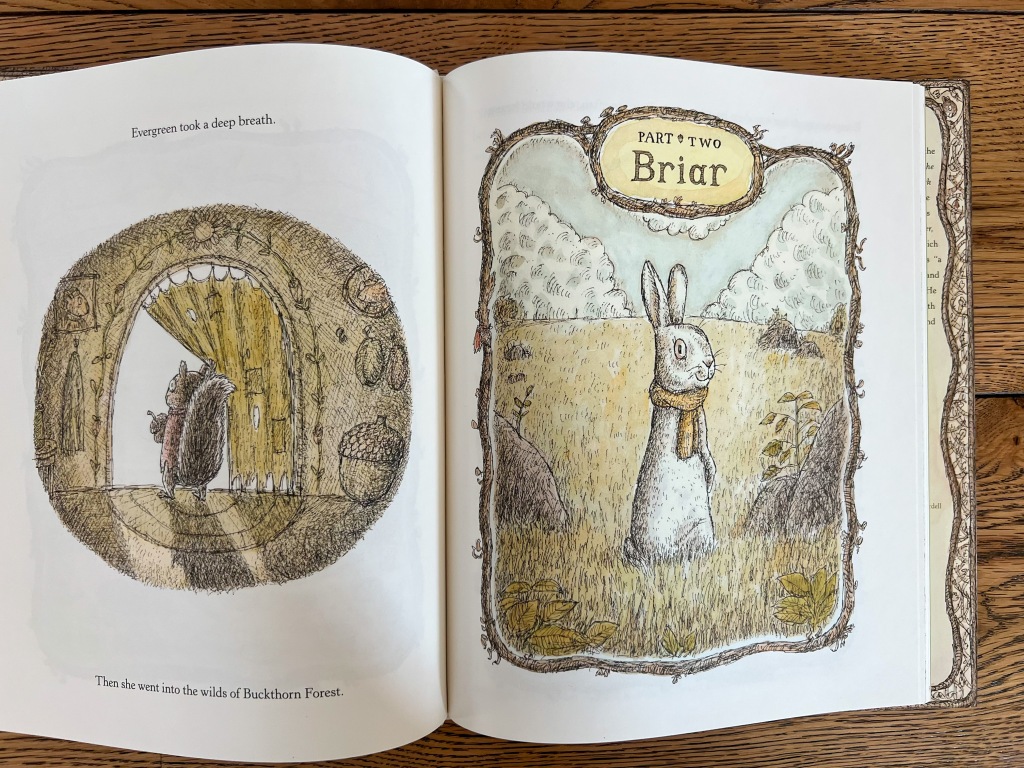
Delivered in six parts, the book lends whimsy and humor to the archetypal hero’s journey, normally reserved for longer works of literature. Evergreen, the unexpectedly intrepid squirrel at the center of the story, is tasked with bringing an acorn-full of her mother’s healing soup to sick Granny Oak. To do so, she must traverse the “wilds of Buckthorn Forest,” and herein lies the problem. Evergreen is afraid of many, many things. Like loud noises and meeting new people, like swimming and germs and thunderstorms. Like anything outside her front door—including the dark forest.
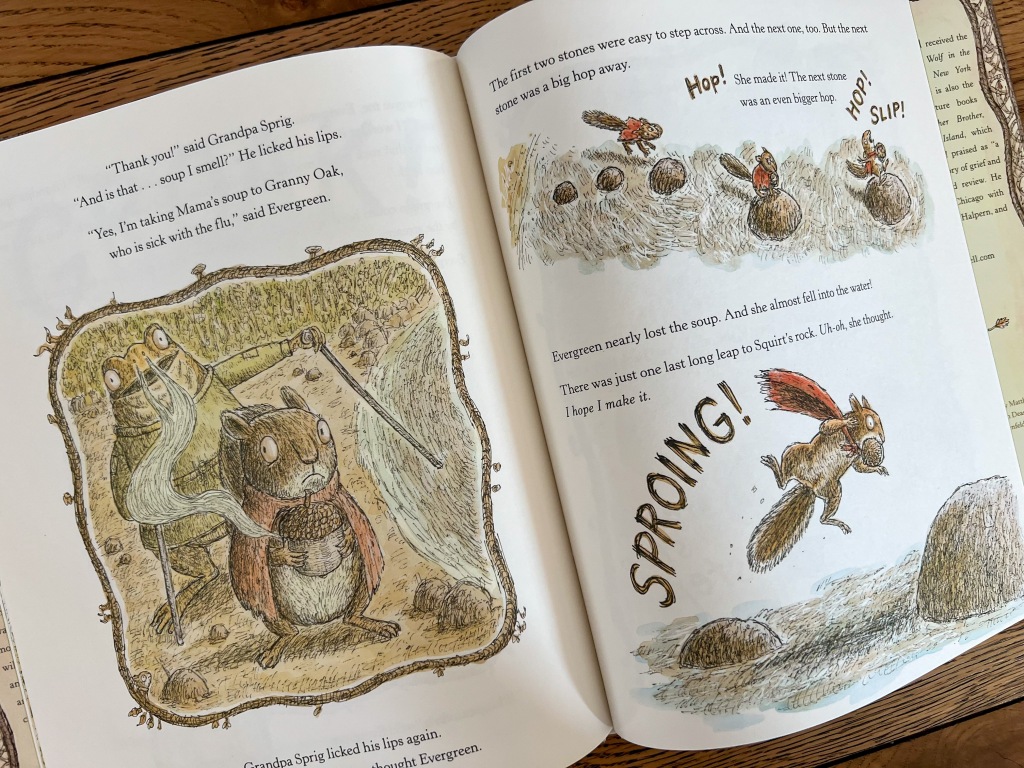
But Granny Oak needs help, and Evergreen is the only one who can provide it. So, despite her fear, despite her self-doubt, she sets off. True to form, her journey is perilous, with challenges mounting at every turn. But it’s also full of sweet surprises, new friendships, and the dawning awareness that we can hold space in our hearts for fear and fun. (Did I mention there’s a map of the forest underneath the jacket cover? Swoon.)
For the Lover of Tiny Things
The Hidden World of Gnomes
by Lauren Soloy
Ages 3-8
While we’re waiting for the next installment of Phoebe Wahl’s Little Witch Hazel (that’s right, coming in 2025, we’re getting a sequel to My Favorite Books of 2021!), Lauren Soloy has us covered with a 96-page foray into The Hidden World of Gnomes, a deep dive into another magical forest world and a cozy reminder that if we choose to see it, the natural world is abuzz with magic.
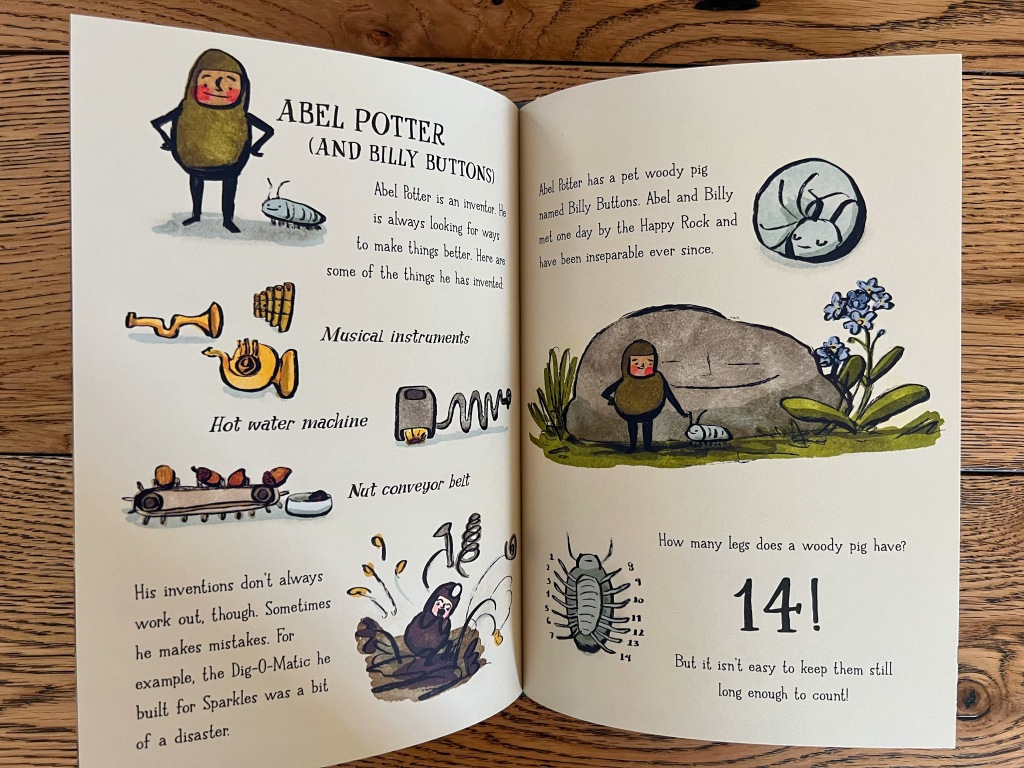
In cheeky fashion, the book applies an investigative tone to the Hidden Folk known as gnomes, who reside “in a happy place they call The Rocket” but which is actually “all around [us], all the time.” Right out of the gate, it’s impossible not to be enchanted by these sweet-faced gnomes, with names like Beatrix Nut and Rose Gladly, and the joy they derive from the big and little transformations around them, especially during their full moon celebrations. They even have a bounty of words for appreciating natural beauty, including “bumblebuzzing,” “blossom bathing,” and—my favorite—“heart-seeing.” Gnomes, we learn, are well versed in storytelling, stick tapping, letter writing, and crafting. Their mushroom-gathering skills are epic; they’re not above competing to see who can stack the most snails; and nothing beats the thrill of leaf riding in the fall (acorn helmets required).
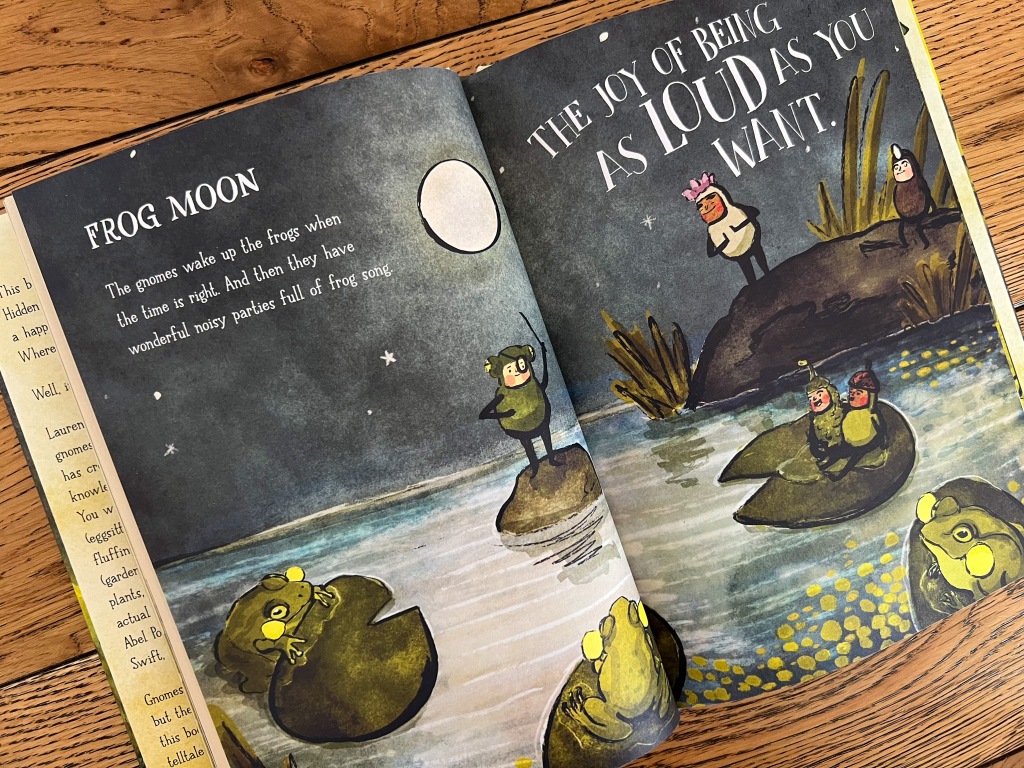
Children will love the extensive world building, while their adults will appreciate imparting a myriad of simple (and free!) pleasures, from the “joy of a breeze scented with flowers” to the “joy of whispering good night to someone and hearing them whisper it back.” Abundant loveliness for all.
Have you enjoyed this post? Make sure you don’t miss others! Enter your email on the right hand side of my homepage, and you’ll receive a new post in your inbox 2-4 times a month. Plus, follow me on Instagram (@thebookmommy), where I’m active most days, posting reviews and updates on what my kids are reading, or Facebook (What To Read To Your Kids) and Twitter (@thebookmommy).
All opinions are my own. Links support the beautiful Old Town Books, where I am the children’s buyer (and yes, we ship!).
Related
Tagged: 2023 Gift Guide, Airin O'Callaghan, Amy June Bates, Andrea Beaty, Andy J. Pizza, Anna Pirolli, art of storytelling, Asian-American characters in children's books, bedtime stories, Briony May Smith, characters with disabilities in children's books, children's books about imagination, Cinderella stories, creativity, David Roberts, dogs, food in children's books, Freya Hartas, gnomes, horses in children's stories, Jerome Pumphrey, Jessica Long, Julien Chung, kids navigating feelings, Kitty O'Meara, Lauren Soloy, leadership in children's books, Linda Bailey, math in children's literature, Matthew Cordell, mermaids, Miranda Paul, Monica Wesolowska, penguins, sensory development, Sophie Blackall, Sophie Miller, teachers, Vanessa Roeder, X. Fang
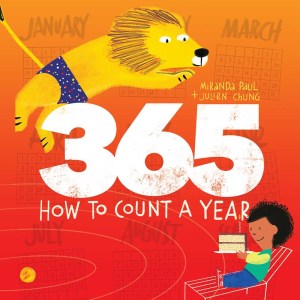
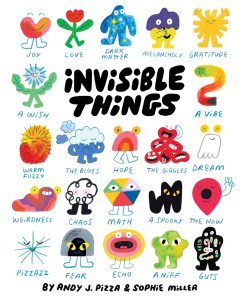
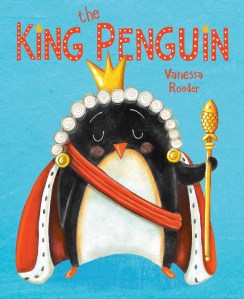

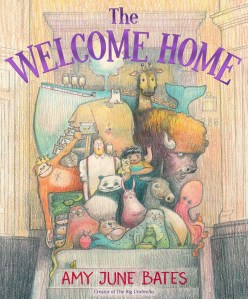
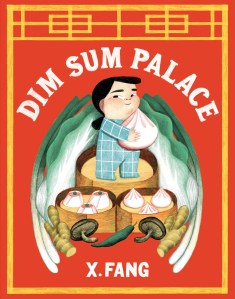
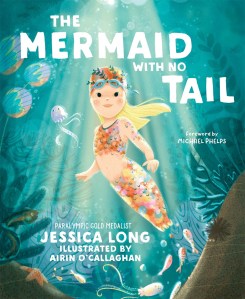
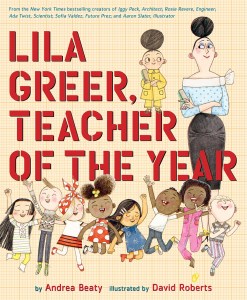
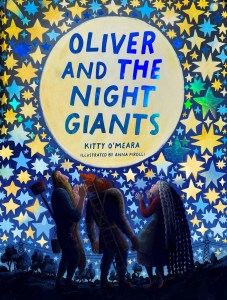
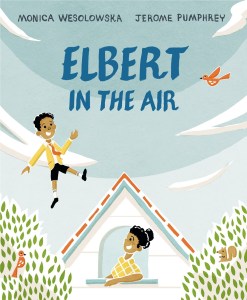
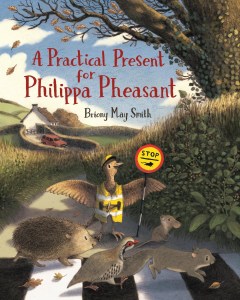
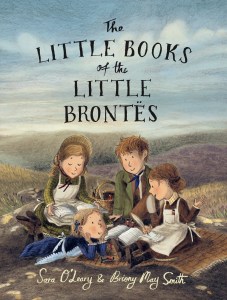
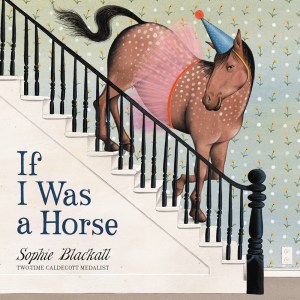
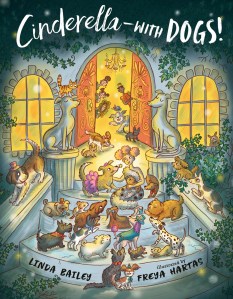
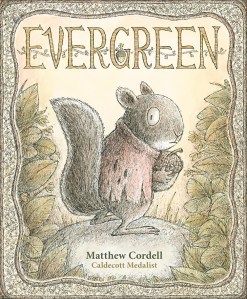
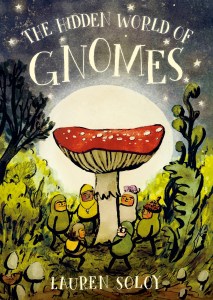
Gotta get my list put together for Christmas.
<
div>Love, Dad
Sent from my iPhone
<
div dir=”ltr”>
<
blockquote type=”cite”>